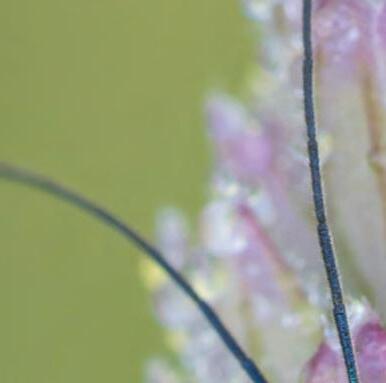
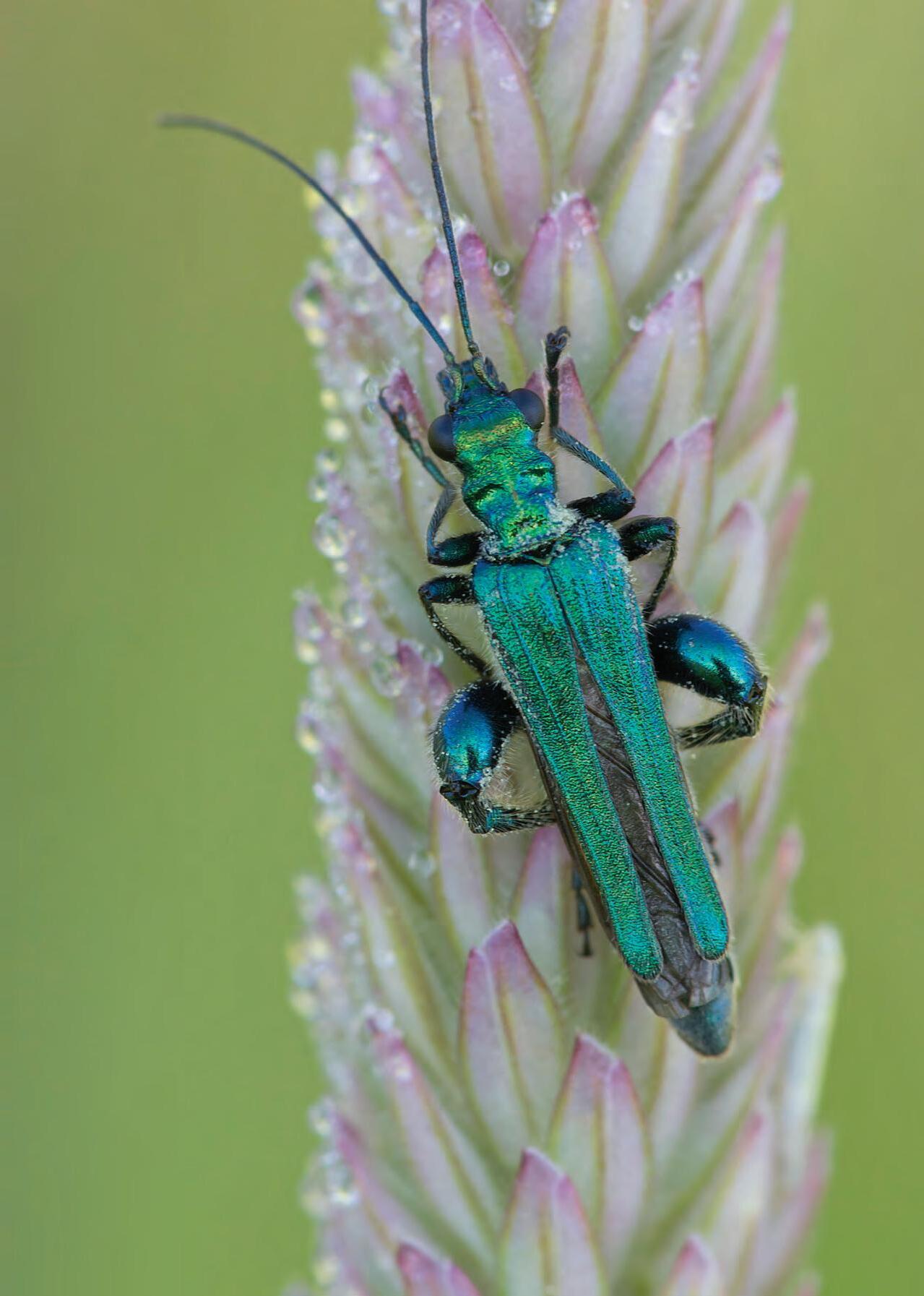



On the hunt for the jewels of the underbrush
Why the Government’s planning reforms undermine wildlife
CELEBRATING 25 YEARS
The extraordinary history and wildlife of Greenham Common


I need to be straight up with you: the Government has broken its promise to protect and restore nature through its regressive Planning and Infrastructure Bill. Then in the Comprehensive Spending Review it made further cuts to DEFRA, keeping nature-friendly farming barely treading water.
After years of progress in speaking up for nature, our resilience is being tested to say the least. Nature protections on so many levels are under threat. You can read more about this disturbing situation on page 15.
While taking a battering, we will continue to fight for wildlife in these three counties we hold so dear. We will work to protect every last square inch of land and work in partnership with farmers, landowners and communities to make this a reality. And we will continue to buy land as part of our future strategy. I ask you to back us in our mission; all who care so deeply about nature must stand together.
In this issue we are also celebrating the 25th anniversary of the return of Greenham and Crookham Commons to the public. These commons are unique, with a truly astonishing variety of wildlife. Turn to page 10 to read about the remarkable journey of the site, from airbase and nuclear weapons store to the largest continuous tract of open heath in Berkshire that is home to some of our rarest ground-nesting birds.
Late summer is a magical time to be out in nature. If you can, why not visit a nature reserve near you and be at one with the natural world? In our ever-busier lives, time spent in wild places can recharge our weary souls and keep us grounded.
Thanks as ever for your incredible support – we need you more than ever!

Estelle Bailey MBE, Chief Executive
Wild Berks, Bucks & Oxon is the membership magazine for Berks, Bucks & Oxon Wildlife Trust
Contact 01865 775476, info@bbowt.org.uk
Membership 01865 788300, membership@bbowt.org.uk
Address The Lodge, 1 Armstrong Road, Littlemore, Oxford OX4 4XT
Website www.bbowt.org.uk
President Steve Backshall
Chair George Levvy
Chief Executive Estelle Bailey MBE

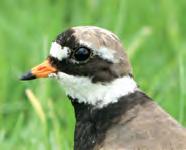

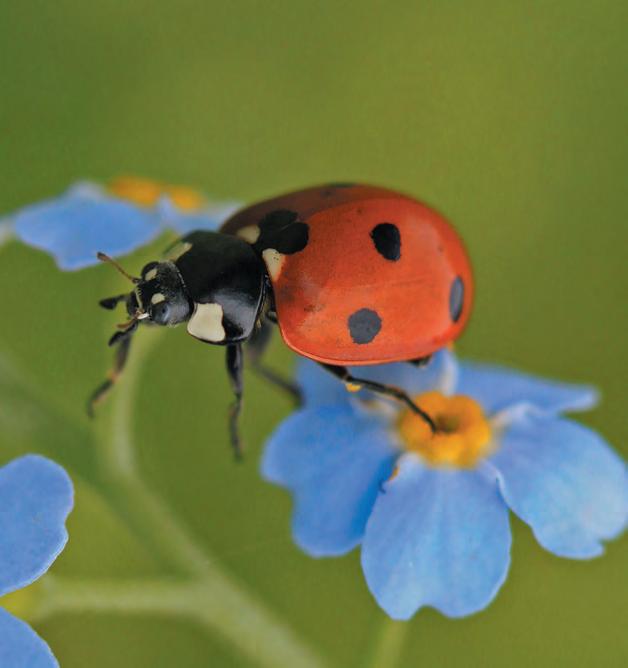
Wherever you are in the country your Wildlife Trust is standing up for wildlife and wild places in your area and bringing people closer to nature.
Wild Berks, Bucks & Oxon is brought to you by Editor Benedict Vanheems
UK Editor Joanna Foat
UK Designer Ben Cook
Design Yorkshire Wildlife Trust Design Studio
Print CKN Print Ltd
Cover Thick-legged flower beetle: Bernard Castelein/naturepl.com

A large-print version of Wild Berks, Bucks & Oxon (text only) is available on request. Call 01865 775476 or email info@bbowt.org.uk
Enjoy the extended version of Wild Berks, Bucks & Oxon online at bbowt.org.uk/publications

The best of the season’s wildlife and where to enjoy it on your local patch
Hedgehogs are nocturnal creatures, scurrying around your neighbourhood at night, visiting allotments, gardens and the hedges around sports pitches and recreation grounds. Summer evenings are a good time to see these delightful mammals snuffling through the leaf litter on the lookout for beetles, caterpillars and worms.
The average adult hedgehog has 5,000 to 7,000 inch-long spines over most of its body, with grey-brown fur on its face, chest and belly. Attract them into your garden with special hedgehog biscuits and shallow saucers of water they can easily drink from. Start making piles of leaves and wood in a quiet corner ready for them to hibernate over winter.
SEE THEM THIS SUMMER
In parks: Parks with lots of hedges around the edges offer the best chance of spotting a hedgehog. Head out for a dusk walk and keep an ear out for their rustling.
In your garden: Hedgehogs may visit your garden too, if they can easily walk in and out. Make holes in fences with your neighbours to create a hedgehog highway. Find out how at bbowt.org.uk/hedgehog-hole

Hedgehogs can swim surprisingly well, their air-filled spines aiding buoyancy. During hibernation their heart rate slows from a rather rapid 190 beats a minute to just 20.
Thank you
Your membership helps protect mammals like hedgehogs by funding work on our nature reserves and in the wider landscape beyond.
Offer food for caterpillars to help them transition to colourful adulthood.
Caterpillars are the second or larval stage of the four-stage lifecycle of all moths and butterflies. It is when these insects are most vulnerable to predation, which explains why some caterpillars are in camouflage to blend in with their surroundings. Others have brightly coloured skin to put off a hungry bird, while some have a multi-layered covering of hairy tentacles.
Moths and butterflies lay their eggs on host plants for their caterpillars to start eating the moment they emerge from the egg
Cinnabar moth caterpillars on ragwort.
Caterpillars are insects with six proper legs and up to five pairs of short prolegs that help them move with a wave-like motion.
stage. This enables them to grow as quickly as possible, sometimes shedding their skin several times before they metamorphose into the pupa or chrysalis stage.
Look for caterpillars of peacock, small tortoiseshell and red admiral butterflies among the nettles. Cinnabar moth caterpillars devour ragwort plants. Long grasses are favoured by speckled wood, gatekeeper, ringlet and meadow brown. Spot hairy caterpillars of garden tiger moth on dandelions.

The leaves of deciduous trees start to change colour as daylength shortens and temperatures fall. Cold nights destroy the chlorophyll that produced green leaves in spring, which fades to reveal the yellow pigment of carotenes. In dry, sunny autumns, the anthocyanins that produce reds and pinks become more intense, especially if temperatures remain above freezing.
Horseshoe vetch is the only host plant for caterpillars of chalkhill blue and Adonis blue butterflies, while small blue butterfly caterpillars feed exclusively on kidney vetch.
Grow caterpillar host plants to help them through this vulnerable stage in their lifecycle. Learn what plant hosts which butterfly: bbowt.org.uk/attractbutterflies
Make habitat piles by stacking twigs, sticks, leaves and other plant material to offer shelter for butteflies and moths to safely sit out the winter.

Savour the summer
Make the most of summer. Get out there and see if you can spot any of these highlights.
Dog days
Dogrose flowers have five heart-shaped pink and white petals and a delicate scent.
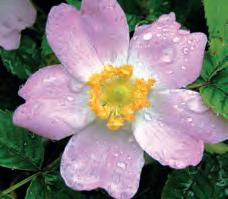

Swift departure
Swifts pair for life, returning each spring to their usual nest site to raise their fledglings. The ‘screaming skies’ fall silent in August as they return to Africa.

On hot, summer days choose cool woodland walks to spot young fox cubs playing in the dappled shade.
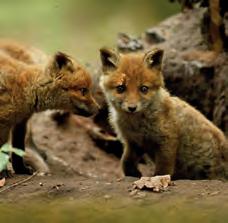


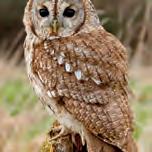
Young tawny owls establish their territories in late summer. Listen for the high-pitched ‘twit’ or ‘ke-wick’ call from the females and the males’ ‘twoo’ reply.
Visit our Chilterns chalk grassland reserves to admire the mauve flowers of autumn and Chiltern gentians: bbowt.org.uk/Chiltern-and-autumn-gentians


Community is at the heart of our response to the nature crisis, says Nigel Hopper, Head of Community Organising
How do you help nature at home?
Primarily in the garden, which in truth is my wife’s passion more than mine! There are plants for pollinators, a small pond, and a willingness to let nature run wild. Bird feeders, however, had to go as they were creating an ecological trap for garden birds in a neighbourhood with more than its fair share of cats!
What’s your favourite type of wildlife?
I love birds. My favourite species since childhood has been the common
kingfisher, but I also have a soft spot for magpies and other corvids, which were the focus of my academic ornithological research. My favourite wild place is the windswept coast.
What do you hope to achieve through your role at BBOWT?
Political consultant Marshall Ganz describes community organising as ‘equipping people with the capacity to build the power they need to get the change they want’. So my role at BBOWT, along with my fabulous team, is to help local people organise themselves to deliver the changes for nature that they want to see in their communities.
Why is getting communities involved so important?
Nature is in crisis, and such is the scale of that crisis that community-scale solutions are necessary. Also, when local people organise themselves to take action for nature, that action becomes rooted in community and therefore sustainable over the long-term.
#TeamWilder
Discover more ways to get closer to nature. Join in at bbowt.org.uk/ team-wilder
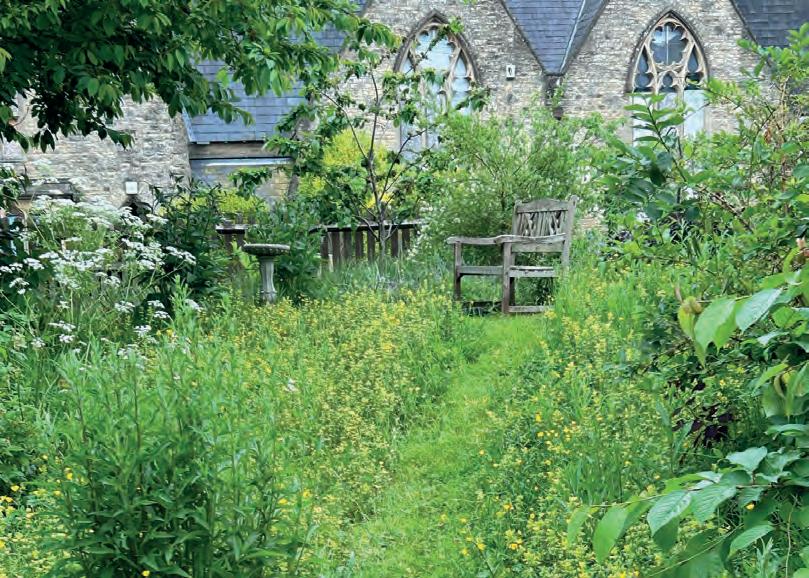
The Bicester Community Wellbeing Garden (below left) was established in 2018 on the site of the old St Edburg’s school. It is run by Grass Roots Bicester, a volunteer group interested in gardening, conservation, and caring for the people and nature of the town. Members of all ages benefit from access to the green space, both to care for it and to socialise. Grassroots Bicester has a licence from owners Value Retail (Bicester Village) to use the ground as a garden until the end of this year.
The garden has steadily grown over the years with the addition of a shed and small greenhouse. It is planted with a mix of wild and domesticated vegetables, fruits, herbs and flowers. We need help maintaining the flowerbeds and growing produce in our three high planters and greenhouse.
The garden is open to the public whenever volunteers are on site. Volunteers typically meet on Wednesday mornings throughout the year, and Saturday mornings in summer. Opening times are advertised through the Bicester Community Wellbeing Garden Facebook page and a noticeboard on Piggy Lane. We would like to extend the opening times but need more volunteers to do so. Please come along on a Wednesday morning or email Anne Marie for more information: annemarie.cromarty@gmail.com
If you or your group would like to become a part of BBOWT’s Community Network please visit bbowt.org.uk/team-wildercommunity-groups
A unique conservation project could be about to start a revolution in conservation. BBOWT is working with Butterfly Conservation to train volunteers to hunt for glow-in-thedark caterpillars. The technique has never been widely used to collect official statistics before. The hope is it could make surveying butterflies and moths significantly easier, while revealing hidden secrets about their behaviour.
The first training session was held at Finemere Wood, Bucks, for staff and volunteers who were on the lookout for caterpillars of the UK’s five species of hairstreak butterfly, including the endangered black hairstreak. The session was part of our Reconnecting Bernwood, Otmoor and the Ray partnership project, funded by
the National Lottery Heritage Fund, which aims to restore habitat in the area for threatened species.
Hairstreaks have been surveyed for decades but it can be a painstaking process – for example, searching for the tiny pinhead-size eggs of brown hairstreaks on twigs in the depths of winter. The new technique involves simply shining a UV light into the bushes and trees to make the luminous larvae gleam. Many other caterpillars glow in this way, though scientists still don’t have a full list of which ones.
You too can help look for glow-in-the-dark caterpillars. Find out how at butterflyconservation.org/uv

Congratulations to our Chief Executive, Estelle Bailey, who received an MBE in the King’s Birthday Honours list. The

award, for services to nature recovery, recognises her remarkable achievements during a 25-year career with The Wildlife Trusts and her 11 years heading up BBOWT.
“Estelle’s drive and determination has seen BBOWT transformed into an organisation focussed on people, social justice, inclusion and harnessing behavioural change to help reach a key vision of ‘more nature everywhere, for everyone,” says George Levvy, Chair of the Trust.
We are incredibly proud of Estelle, who adds: “I am so grateful to receive this honour, which reflects the remarkable team I have the privilege of working with.”
Keep up to date
Visit bbowt.org.uk/ newsletter to sign up for our latest news, delivered to your inbox.
The Great Big Nature Survey is the biggest people and nature survey in the country and seeks your opinions on some of the biggest questions surrounding nature and our collective role in caring for it. Make your voice heard at wildlifetrusts.org/ great-big-nature-survey


The Wildlife Photography Competition 2025 is open and with it your chance to share your passion for wildlife through the camera lens. Submit up to four photos across eight categories for an opportunity to win a bundle of great prizes, from a smart bird feeder camera to a photography masterclass. Full details at bbowt.org.uk/photocomp25

We look forward to welcoming many of you to this year’s Annual General Meeting, which will be held on 25 October at Didcot Civic Hall. Turn to page 13 for more details.
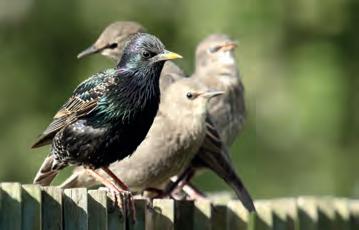
Earlier this year, The Wildlife Trusts celebrated the UK Government’s decision to licence reintroductions of beavers into the wild in England and acknowledge free-living populations for the first time in 400 years.
The Government’s decision to accept applications to return beavers into river catchments in England enables this native species to roam wild in our rivers and lakes once more.
In Wales, The Welsh Beaver Project, led by Wildlife Trusts in Wales, is currently waiting for the Welsh Government’s decision on the protected status of beavers following a consultation.
Currently, only 14 per cent of rivers in the UK are considered to be in good ecological condition. Beavers are natural ecosystem engineers – experts at creating healthy wetlands. Their dams retain, release and filter water, restoring natural wetlands, rivers processes and wildlife too.
The Government recently committed to spending billions of pounds on hard infrastructure to combat flooding as

well as compensating farmers for lost crops due to changing weather patterns. Releasing beavers represents a naturebased solution to many problems our rivers face and is shown to significantly reduce flood peaks, as acknowledged by our report into natural flood management. The return of beavers has been carefully planned over a long period of time. Natural England has developed a detailed licencing regime and application process so stakeholders are engaged, landowners supported and wetlands are created to improve wildlife and the health of rivers.
To find out more information about wild beavers near you, visit wildlifetrusts.org/beavers
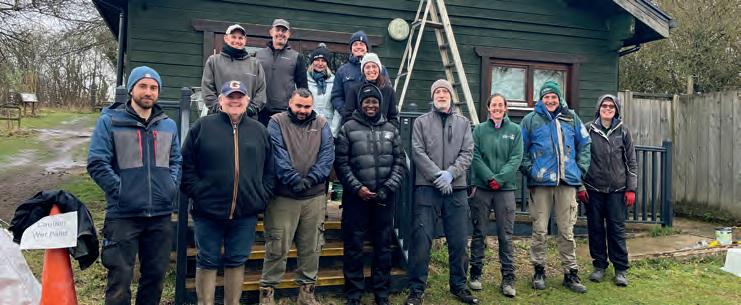
Welcome to our newest Investors in Wildlife business members: Harwell Campus and OCU Group. Thank you to those renewing their memberships, including Blenheim Palace, Freeths LLP, Johnson Matthey plc, Karl Storz Endoscopy, Nature Bureau, Pacific Produce, SDC Builders Ltd and The Castle Hotel Windsor.
We were delighted to be joined by Bowles & Wyer for their recent Wild Work Days at College Lake. Teams removed
fast-growing willow trees and hawthorn saplings to help maintain our rare open chalk grassland habitat. Another team painted the outside of some our educational buildings and updated the pond dipping area with fresh play bark. Their hard work contributes to College Lake’s role as an outstanding centre for wildlife and people.
If your businesses would like to act for nature contact us at partnerships@bbowt.org.uk
Discover how The Wildlife Trusts are helping wildlife across the UK

Manx Wildlife Trust in collaboration with Visit Isle of Man announced the inaugural Biosphere Photographers in Residence for 2025. Ciara Hardisty and Adam Morgan’s work will contribute to a lasting artistic legacy that highlights the Isle of Man’s distinctive status as the world’s only whole nation UNESCO Biosphere Reserve.
The only native British species in the World’s 100 Most Threatened Species list was discovered by Leicestershire and Rutland Wildlife Trust at Rutland Water. The willow blister fungus (Cryptomyces maximus), recorded in England for only the second time since 1876, was previously only known in a few places in Pembrokeshire.
The annual count of snake’s-head fritillaries at BBOWT’s Iffley Meadows in Oxfordshire recorded nearly 30,000 flowers, a dramatic increase on 2024’s total of just over 6,000 when prolonged flooding took its toll. The jump confirms the wild flowers are recovering. When the very first count was held in the early 1980s just 500 flowers were reported.
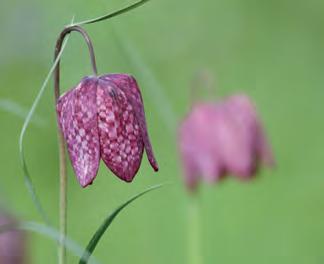
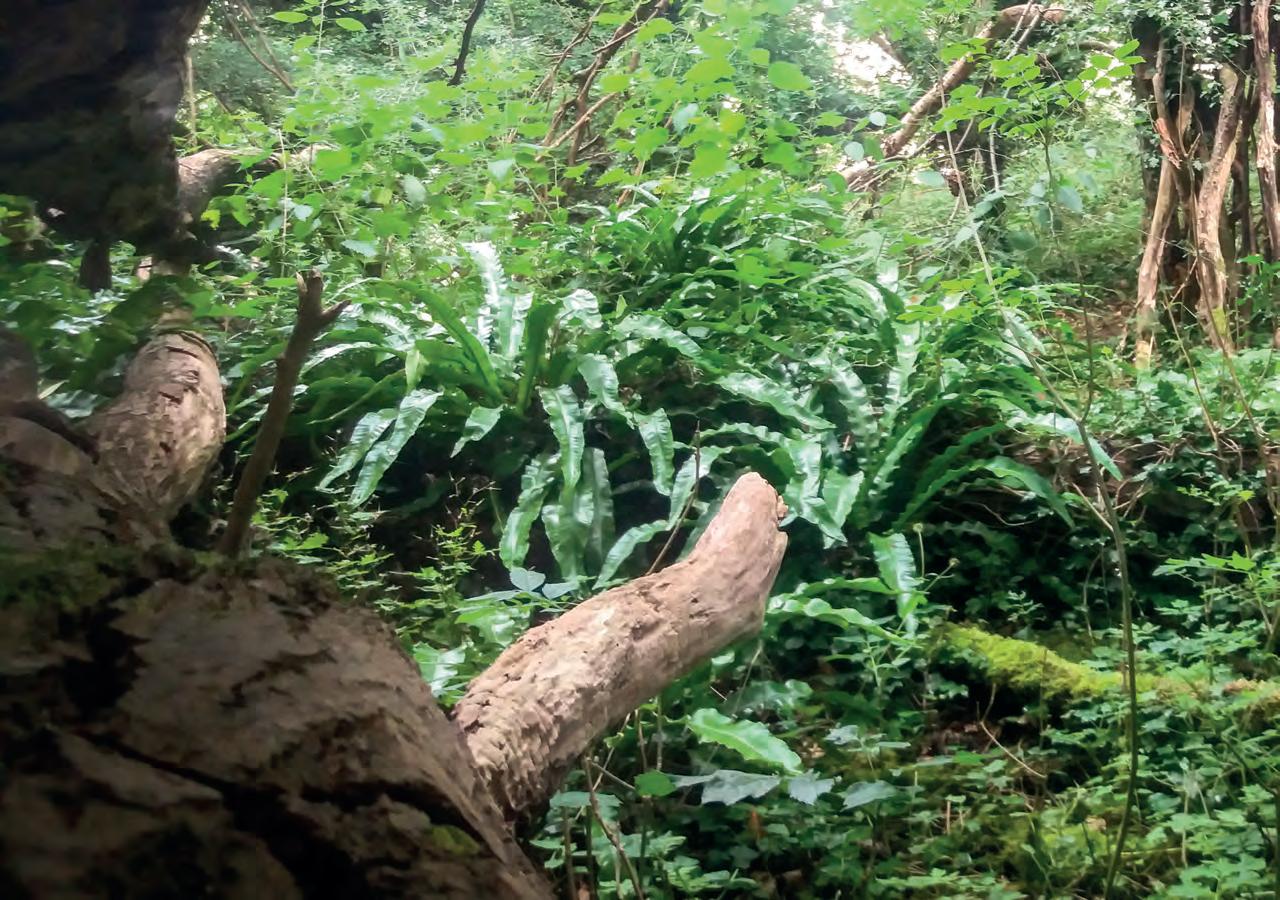
Fantastic ferns, magical mushrooms and purple emperors await intrepid explorers to the hidden lush woodlands of BBOWT
Postcode OX15 5JR
Great for... Ferns and mosses
Size 8 hectares
Map ref SP 360 323 what3words expand.pies.reconnect
Large emerald ferns sprout from the ground, rotting logs teem with vibrant mosses, and dappled sunlight filters through the twittering canopy above. It looks like a tropical rainforest, but it’s a nature reserve in West Oxfordshire.
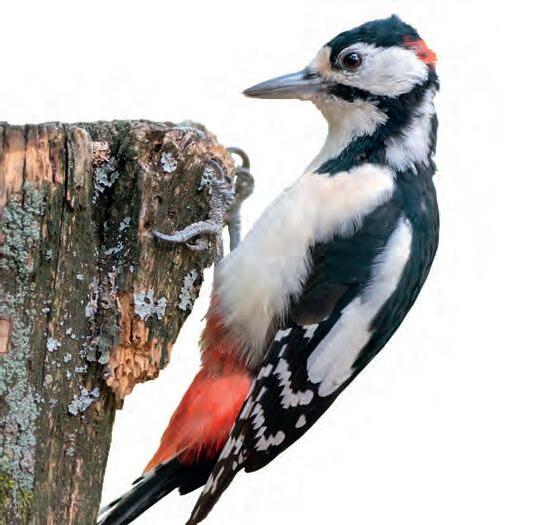
This eight-hectare strip of hillside once carried a Great Western Railway track used to transport iron ore from Hook Norton to the blast furnaces of the Midlands. Part of the track was held up by huge stone viaducts known as ‘Oxfordshire’s pyramids’, which still stand today, rising out of the woodland like ancient ruins.
The oak, field maple and ash trees are home to a host of native birds, including great spotted and green woodpeckers, garden warbler, blackcap, whitethroat and goldcrest, while badgers make their
Hook Norton Cutting is home to some fine examples of Jurassic oolite limestone, which is more than 145 million years old! This rock, stained a vibrant red by iron oxide deposits, conceals numerous fossils.
home in the ground below. The remaining retaining walls of the railway track are a lichen and moss-spotter’s dream, with exotic-sounding varieties such as spiral extinguisher-moss, bristly fringe-moss, woolly fringe-moss and comb-moss thriving all around the site.
Follow the footpath up onto the ridge that used to carry the railway track, and ferns start to sprout up between the fallen branches in dells on the hilly ground: smooth and shiny hart’s-tongue fern and corrugated male-fern. These species are all typical of ‘the English rainforest’ – high-humidity, sheltered woodland of a kind that was once much more common in the British Isles. The warm, damp days of late summer and autumn are the perfect time to see this historic habitat at its best.
We are only able to maintain wonderful woodland reserves like these because of the generous support of all our members and donors. Thank you.

Take only photos
We have previously had problems with people picking mushrooms at our nature reserves. Please remember that foraging is not allowed on any of our sites. Take only photos, leave only footprints.

Rushbeds Wood is more than just a woodland, with wildlife-rich hedgerows, rough grassland, and dazzling wildflower meadows. There is an incredible array of biodiversity at any time of year, including wonderful plants like pendulous sedge, townhall clock, opposite-leaved golden saxifrage, great burnet, and dropwort. Breeding birds like whitethroat and blackcap take to the air. Summer is a great time to see butterflies such as black hairstreak and silver-washed fritillary as well as many other invertebrates. There is much to enjoy in autumn too, from the changing colours of the woodland foliage to the hedgerow fruits and, of course, all those fabulous fungi. Phil Townsend, volunteer and member, Buckinghamshire
Got a favourite nature reserve? Tell us about it! Email info@bbowt.org.uk with the subject heading ‘My wild escape’.
Postcode HP18 0RU
Great for... Finding fungi
Size 56 hectares
Map ref SP 673 154 what3words taker.schooling.logo
In 2020, Penny Cullington of the Bucks Fungus Group was wandering through Rushbeds Wood when she stumbled upon two species of fungus that had never been recorded in the UK. Her dramatic discovery highlights what a mycological treasure trove this woodland of oak, ash, maple and hazel is, with amethyst deceiver, wood blewit and green and scarlet elfcups among the other highlights.
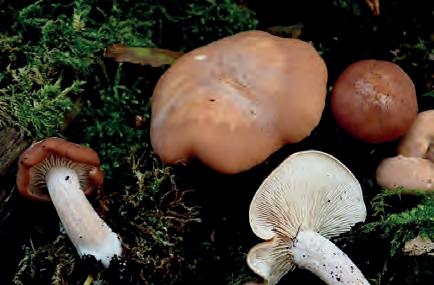
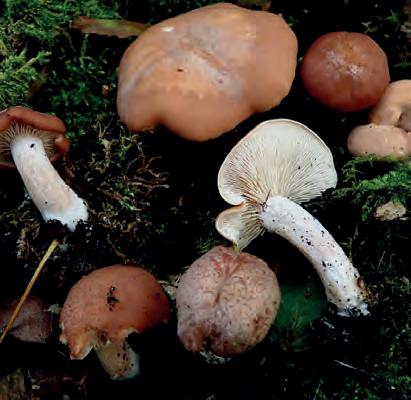
Great spotted woodpeckers hammer into the trees, red foxes
Postcode RG17 9QT
Great for... Common lizards
Size 12 hectares
Map ref SU 382 643 what3words puzzle.diplomas.flags
This hidden remnant of ancient heathland just southwest of Newbury is home to a surprising array of species. Common lizards, grass snakes and slow worms bask and hunt beneath the vibrant pink flowers of the bell heather through
burrow into the ground beneath, and get out early in August and you might also be lucky enough to catch a final glimpse of the magnificent and scarce purple emperor butterflies. Send us a picture if you do!
the summer and autumn. Iconic red-and-white fly agaric toadstools sprout from August to December, while song thrushes trill in the gorse bushes and kestrels circle overhead.
Explore the reserve and surrounding area with our Inkpen Wild Walk. Starting in Kintbury, this 17km circular route takes in the common and our Inkpen Crocus Field reserve. Find a map at bbowt.org.uk/wild-walks
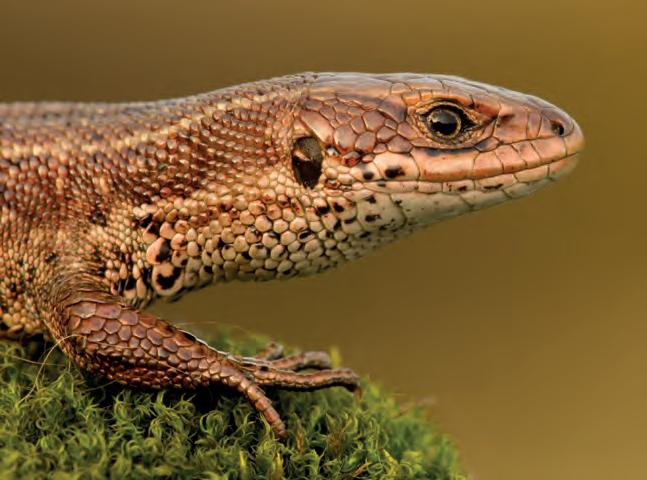
On 8 April 2000, local people, press and dignitaries gathered for the reopening of Greenham Common. It marked an end to more than 60 years of military occupation and the chance to explore the wildlife held for so long behind barbed wire fences. Reserves Officer Adrian Wallington recounts the lead up to this historic day and the magical wildlife found here.
Greenham and Crookham Commons boast an incredible variety of wildlife and equally rich history. The nature reserve extends beyond what was once an airbase to cover almost 450 hectares (1,100 acres). The special wildlife and habitats found here make up the biggest continuous stretch of heathland in Berkshire and our biggest nature reserve.
This year marks a quarter of a century since the Commons were returned to the public. The site’s military history has shaped the landscape we see today. During the various airbase redesigns, much of the land was rolled, flattened, scraped and mown, creating a diverse mix of species-rich acid and neutral grasslands and heathland.
The heathland lies on top of a gravel plateau laid down at the end of the last
ice age. Poor in nutrients, baked dry in summer and soaked in winter, the gravels create the harsh conditions the heathland needs to thrive. Adding to the variety of habitats is the decades-long leaching of the concrete runway, which has created contrasting alkaline soils suited to species more commonly found on chalk grasslands. Where underlying clay soils hamper rainwater runoff, seasonal pools and ponds spring up in wetter months, making this a dragon and damselfly hotspot. Large areas of semi-natural and ancient woodland are found at the edges of the flat plateau, along with remnants of wood pasture with its old, gnarly oaks. Deep alder-lined gullies remain wet throughout the year.
As the chain to the gates is cut on that day in 2000, the size of the crowd rushing into this once-restricted area was modest
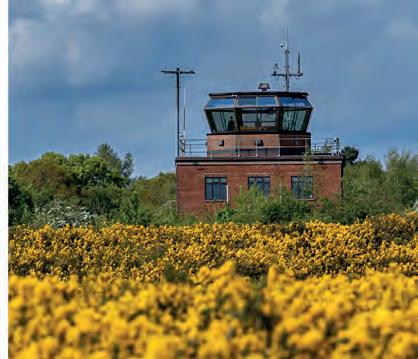
The old control tower contains a café for post-walk cuppas.
set against the enormity of the Commons and its history.
There is no doubting the military interest in Greenham Common as a camp or base, with the earliest dating back to 1740. The first aircraft landed here in 1930 and by 1944 an airbase was home to over 400 aircraft, 12,000 airmen and more than a thousand gliders preparing for D-Day. It was in June 1944 that General Eisenhower stood before American troops
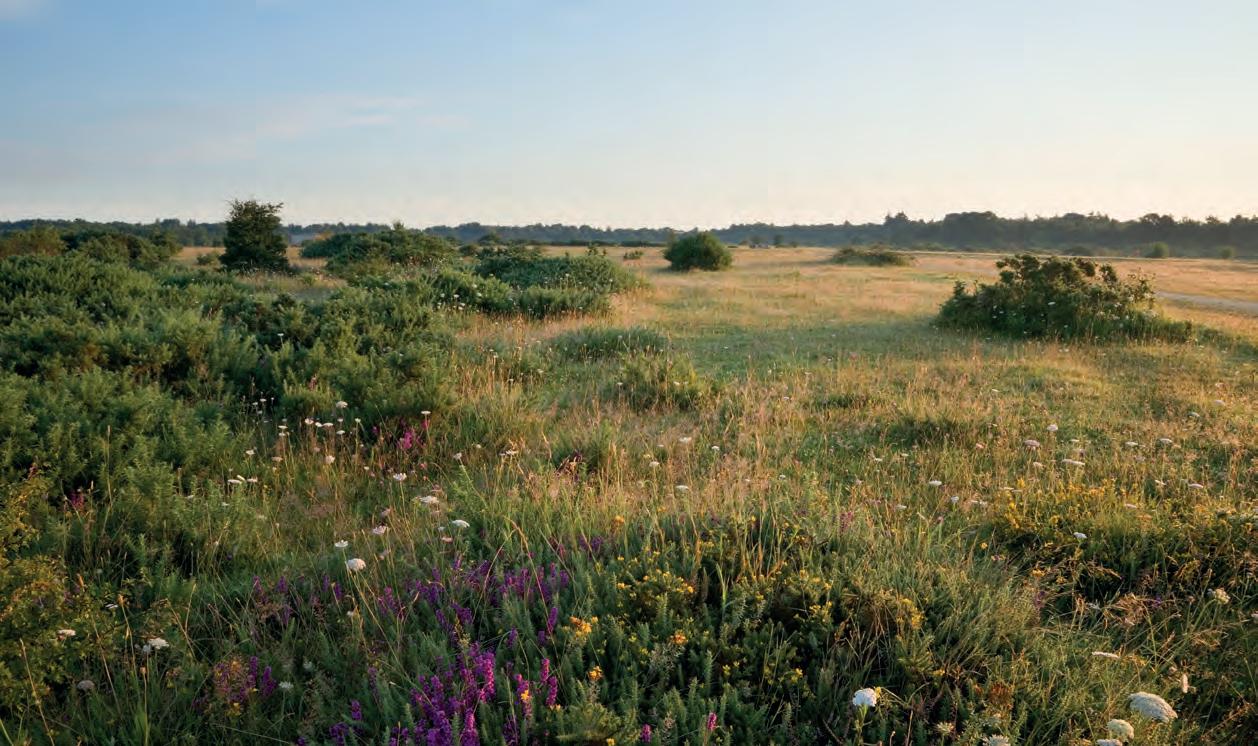
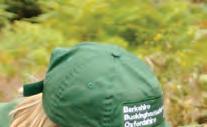

at Greenham to give his famous ‘The eyes of the world are upon you’ speech.
The storing of nuclear weapons here in the 1980s was perhaps the site’s most divisive period. Missiles were kept in constant readiness under enormous, foreboding shelters and the remaining fencing, now a scheduled monument, can still be seen from the Common. In 1981 demonstrators against nuclear weapons marched from Cardiff to Greenham and spawned the Peace Women movement, which at its height saw 35,000 protesters arriving from across the country to join hands and ‘embrace the base’.
More than 500 remnants of the Cold and Second World Wars remain, along with some older features dotted around the reserve that add further interest alongside the wildlife. A metal replica of a C-130 aircraft once used for fire training sits next to open gravels. The central section of the former runway, once the longest in Europe and thick enough for the B52 bombers that landed here, gives an idea of former scale. Overlooking it all are the huge glass windows of the 1950s control tower, now a visitor attraction.
Decommissioning the airbase involved extensive restoration. Seed collected from established heathland was spread on bare gravels and a million tonnes of concrete and gravel removed, much of it used under the Newbury Bypass. Leaks from the many fuelling stations meant the gravels had to be regularly turned through a process called bioremediation, which continued after the Common reopened.
The Greenham and Crookham Commons Act was finally ratified in 2002. It conferred powers to the local council with the aim of restoring the natural beauty of the Commons, improving access, restoring commoners’ rights, and setting up a commission to oversee the site’s management. BBOWT sits as an appointed advisor to this commission.

By 2001, some 14km of new stock fencing and cattle grids had been installed, enclosing around 380 hectares for grazing cattle and eventually Exmoor ponies.
There are now around 100 privately owned cattle grazing the Commons.
In 2007 we partnered with West Berkshire Council on a 10-year West Berkshire Living Landscape Project and seven years later took over management of the Commons along with other nature reserves owned by the Council, including Snelsmore

Common Country Park, Thatcham Reedbeds and the Nature Discovery Centre in Thatcham. Our experience of managing nature reserves ushered in fresh resources, funding opportunities and expertise, marking a new phase in the Commons’ history.
Management strikes a fine balance between conservation and public access, with thousands visiting every year. Examples of the work involved include cutting six hectares of gorse annually to prevent it dominating, recruiting seasonal wardens to protect groundnesting birds, and cutting and removing countless areas of scrub to keep the heath and grasslands open.
Today’s visitors can enjoy a view from the huge glass panels of the restored control tower. This view, once looking down on B52 bombers and protesters, takes in a vista of rich habitats and fascinating wildlife in a truly aweinspiring landscape.
The Commons have changed markedly but continue to provide the unique experience that those first visitors enjoyed 25 years ago. The open wilderness, the breathtaking diversity of plants and animals, and the poignant reminders of a turbulent past make this a very special place.
Greenham and Crookham Commons are magical any time of year. Plan your visit, take a video tour, explore the interactive map or download one of two circular Wild Walks at bbowt.org.uk/greenham-and-crookhamcommons
With such a variety of wildlife there’s always something to see, including these not-to-be-missed highlights.
This orchid puts on a wonderful display with hundreds, sometimes thousands seen across the grasslands. Its delicate spirals of white flowers can be admired in August and early September.
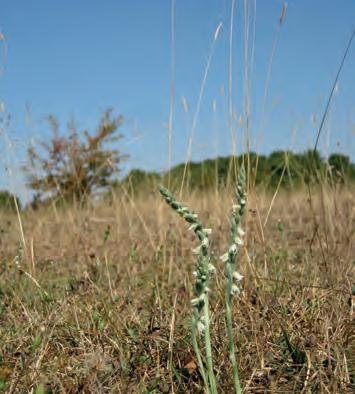
The success of this resident warbler coincides with an increase in suitable gorse cover. Dartford warblers can be elusive but look for them flitting across the higher tips of mature gorse or chattering from within.


Often seen around the bare gravels and heathlands in late summer, this butterfly can be tricky to spot thanks to its camouflaged underside. It has an unusual habit of tilting its wings to one side when basking in the sun.
Hearing a nightjar at dusk is sure to leave an enduring memory. Listen for its mesmerising, drawn out ‘churr’ from open heathland, where it relies on its cryptic plumage to go unnoticed.

On the drier, more open heath common and bell heathers grow in harmony with dwarf gorse, the less vigorous cousin of the taller European gorse. The paler flowers of cross-leaved heath dominate wetter areas.
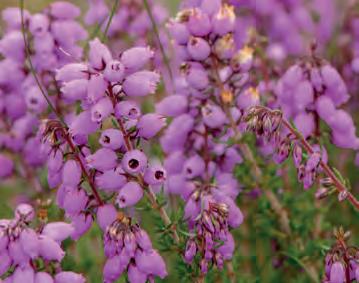
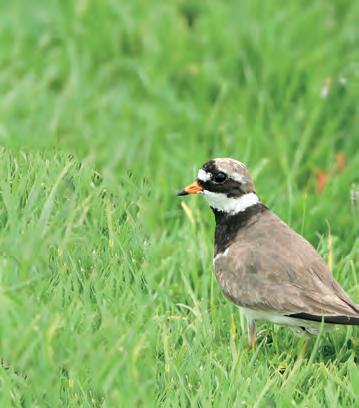
Many rare, specialist birds nest on or near the ground. Lapwing, ringed plover (pictured) and little ringed plover may be seen with careful observation on the open gravels, while others like woodlark sing unashamedly from the sky in spring.
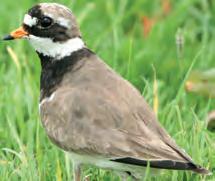
Greenham and Crookham Commons benefit from passionate volunteers who help maintain its tapestry of habitats and associated wildlife.
Greenham and Crookham Common Volunteers: Since their first task in December 1997, this independent group of volunteers has worked to cut scrub, repair fences, clear paths and fix boardwalks across the Commons. They meet on the third Sunday of each month, and you can read more about them at gccv.org.uk
West Berkshire Living Landscape Volunteers: This group works on nature reserves across West Berkshire, including the Commons. The group meets every Wednesday, is led by BBOWT staff and Wildlife Trainees, and is perfect for anyone seeking to experience a variety of sites, including Snelsmore Common, Thatcham Reedbeds, Kintbury Newt Ponds and Seven Barrows.
For more information or to learn how you can get involved with either of these groups, please email volunteering@bbowt.org.uk
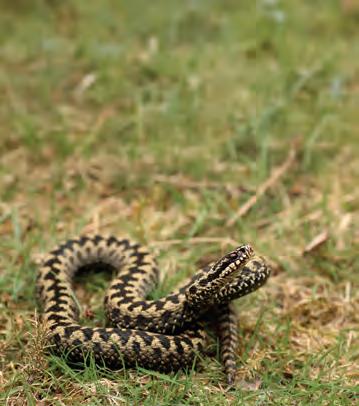
A careful, silent stroll may reveal one of these very shy reptiles. The Commons are an adder stronghold, and the Trust has recently installed two adder tunnels beneath Old Thornford Road to encourage their movement across the site and mixing of isolated populations.
Winter Wreath Workshops
It’s only four months till the start of the festive season, and what better way to welcome in the festivities than by making a beautiful winter wreath to decorate your home or gift to a loved one. Day and evening slots are available, and if you can’t make any workshops, wreath kits are available to order from the website with pick up from Sutton Courtenay Environmental Education Centre (Oxon).
Thurs 27 & Fri 28 Nov, Sutton Courtenay
Sun 30 Nov & Sun 7 Dec, Nature Discovery Centre (Berks)
Sat 6 & Sun 7 Dec, College Lake (Bucks)
Weds 3 & Fri 5 Dec, Woolley Firs (Berks)
Forest Bathing
Sun 3 Aug & Sun 2 Nov, Windsor Great Park; Sun 17 Aug, Sun 14 Sept, Sun 12 Oct & Sun 9 Nov, College Lake
Connect with nature and become more mindful as you relax and utilise your senses during this guided event.
Nature, Natter and Nibbles
Fri 8 Aug & Fri 5 Sept, Sutton Courtenay
Join our learning volunteers for a peaceful stroll through the reserve followed by tea and cake.
Pond Dipping for Beginners
Fri 8 Aug & Sat 25 Oct, College Lake
Explore our wildlife pond and the creatures in it during this hands-on session.
Adults only.
Invertebrate Surveying Techniques
Weds 20 Aug, Woolley Firs
Short course aimed at newcomers to the field with an interest in invertebrates.
Highlights from our busy events diary. For full and up-to-date listings or to book visit bbowt.org.uk/events

Birds and a Brew
Fri 29 Aug, Weds 24 Sept, Fri 24 Oct & Fri 21 Nov, Nature Discovery Centre
Join us for a brew, a talk about birds and nature, and a walk to see what we can find.
Bat Walk
Weds 3 Sept & Weds 1 Oct, Windsor Great Park
Use bat detectors to locate and help identify bats on this walk.
Austrian Scythe Training
Thurs 4 Sept, Sutton Courtenay
Learn how to use a scythe – a satisfying skill for garden/ landscape maintenance.
Bats for Beginners
Tues 9 Sept, Woolley Firs
Our local bat expert will give insights into these fascinating
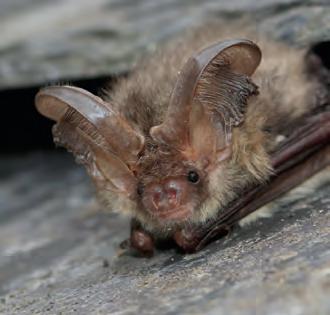
Join us this summer holidays for thrilling family trails, children’s events and fully supervised Day Camps. Find out more and book ahead at bbowt.org.uk/events
creatures on this talk and night walk.
Weave a Harvest Basket
Sun 14 Sept, Windsor Great Park
Create a rib frame basket using willow and a traditional weave.
Watercolour Workshop
Fri 19 Sept & Fri 28 Nov, Nature Discovery Centre
Explore the delights of painting in watercolour in this friendly, no-pressure class.
Fungi Conservation Walk
Fri 24 Oct, Windsor Great Park
Learn about the conservation management of fungi and its importance on this gentle walk.
Fungi Walk and Talk
Sat 25 Oct, Woolley Firs
Delve into the fantastic world of fungi with our expert mycologist.
Celebrate BBOWT!
Sat 25 Oct, Didcot Civic Hall, Britwell Road, OX11 7HN.
Join us for our 2025 Celebration of BBOWT, to include TED-style talks from current staff, a look back at what we achieved in 2024-25, our annual Volunteer Awards, and the keenly anticipated unveiling of the 2025 Photography Competition winners. The day will also include our AGM for members.
Join us from 9.30am for a tea or coffee, followed by the formal business of the AGM at 10am (members only). From 11am, everyone is invited to join us in a celebration of the past year. We’ll hear from our Chief Executive, Estelle Bailey MBE, plus short talks from BBOWT staff about work across our three counties. You’ll also hear about how we’re responding to change in a volatile climate (both political and environmental).
Lunch will be available for those who wish to buy it (advanced booking required), and at 12:30pm we will celebrate our fantastic volunteers, followed by our 2025 Photography Competition winners. The day will end around 1.30pm.
For more details or to book visit bbowt.org.uk/celebration

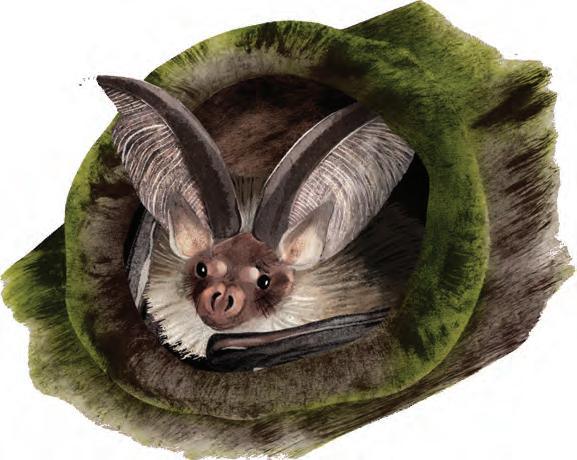
Brown long-eared bat
Humanity’s demands today for nature’s goods and services far exceed her ability to meet them on a sustainable basis. We need 1.7 Earths to maintain the world’s current living standards, and that’s a conservative estimate. But we would not know that by studying the measure most widely used to judge economic success: Gross Domestic Product (GDP).
That’s because GDP does not consider the depreciation of assets, such as wetlands, mangroves, coral reefs, grasslands and forests, that accompany our production and consumption activities. An economy could be enjoying GDP growth for a long while even as the basis on which we produce and consume degrades and shrinks.
The human overreach is reflected in the rate at which species are becoming extinct, currently at some 100-1,000 times the rate of extinction over the past several million years. But when we think of human-induced species extinction, large-scale changes in land use come to mind.
We tend to think of forests being transformed into land for crops, animal farms and plantations; of grasslands transformed into pastures; and of mines and quarries ripping apart dense jungles. But there is a more insidious process at work, which is perhaps as powerful: the bit-by-bit fragmentation of ecosystems that accompanies GDP growth.
Persistent, incremental encroachment into nature is insidious because each move seems near harmless: a new bus lane cutting through an ancient orchard here, a mangrove forest sliced to make way for a luxury hotel there, a bat habitat destroyed to make room for additional housing in an urban sprawl
elsewhere. The problem is, the orchard will not return, the mangrove forest won’t have space to recover its previous glory and the bat population will die because it has nowhere to go.
If at each move human demand is allowed to trump ecological integrity, the landscape that evolves becomes denuded of wildlife. It is there that we each can play a role by minding our own neighbourhood. Unlike global climate change, over which no group on its own can have a marked effect, biodiversity can be protected by communitarian endeavours. Our Wildlife Trusts play an enormous role in protecting and preserving local wildlife.
Projects like the Wildlife Trust for Bedfordshire, Cambridgeshire and Northamptonshire’s acquisition and preservation of Strawberry Hill, a rewilded farm in Bedfordshire, are helping to expand space for wildlife in some of the most naturedepleted areas of the UK. And on a different scale, the same Trust, of which I’m proud to be President, is working with young people in Luton to plant hedgerows in local parks that connect woodlands and other habitats together. This allows wildlife to thrive in the most urban of environments and simultaneously ensures that the local residents are connected to the wildlife that shares their neighbourhood, too. Wildlife Trusts all over the country have similar projects and together we are making a difference.
Done right, nature makes every development high-quality, attractive and sustainable. Read more about our campaign for new developments to work in harmony with nature.
wtru.st/planning-bill
The Wildlife Trusts’ Chief Executive, Craig Bennett, met Professor Dasgupta to discuss the findings of the globally respected review on The Economics of Biodiversity You can catch up on the recording of our WildLIVE on The Wildlife Trusts’ YouTube channel by visiting wtru.st/Economicsof-Biodiversity IN CONVERSATION...
Sir Partha Dasgupta is a globally respected environmental economist and professor at Cambridge University, author of a groundbreaking report on protecting global nature and president of the Wildlife Trust for Bedfordshire, Cambridgeshire and Northamptonshire.
The Government’s new Planning and Infrastructure Bill aims to speed up development, but at what cost? External Affairs and Landscape Recovery Director Matthew Stanton outlines the dire consequences for wildlife and why a change in approach is desperately needed.
Everyone deserves to live with nature on their doorstep.
So you would have thought that in its mission to build 1.5 million new homes the Government would look to bring people together under a shared vision to create new homes that benefit communities and help to restore our declining nature.
But instead of building consensus between groups, the Government salted the earth by using divisive rhetoric in calling people NIMBYs, naysayers, eco-zealots and blockers. They used bats and newts as scapegoats, falsely claiming that nature is a hindrance to development and growth.
We know this isn’t true. The Government’s own impact assessment on its new Planning and Infrastructure Bill concluded there is nearly no evidence that nature blocks developments. Natural England have also stated that they only object to one percent of applications they are consulted on. It’s clear nature is not a blocker, but instead of addressing the skills gap in the construction industry or properly resourcing local authorities so they can recruit the ecologists and officers they need to deal with planning applications, the Government chose to push forward with a Planning and Infrastructure Bill that effectively disapplies some of our most important
and effective nature protection laws.
This is of particular relevance to us in Berkshire, Buckinghamshire and Oxfordshire as our area has been identified by the Chancellor as a key area for growth and new development.
With Heathrow Airport expansion, HS2, the UK’s first AI Growth Zone in Culham, the OxCam Growth Corridor and housing targets more than doubling in some areas, it is absolutely imperative that new development creates new habitats for local wildlife, and new green spaces for local people.
That is why we are especially concerned about the Bill, the essence of which requires developers to pay a fee to Natural England instead of creating habitats on site. Natural England would then use the funds to deliver conservation measures elsewhere, potentially in different parts of the country. The risk is that our three counties take the burden of development but receive none of the environmental benefits.
Benefits to nature need to be delivered locally so that development isn’t seen as a burden but an opportunity. We need a win-win for development and nature, but the Government is proposing a lose-lose. Even some developers dislike the Bill because they would rather create green spaces and habitats on their sites, rather

Newts and bats have been used as scapegoats.
to Natural England. Further to this, there are no guarantees in the Bill that the conservation measures Natural England would carry out would even compensate for the habitats or species lost from development.
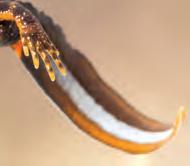
The Government is proposing a ‘cash to trash’ system where nature is bulldozed with no consequences. They are pursuing growth at all costs and it is nature that will pay the price. Please write to your MP and tell them about the woodlands, rivers and animals that you love. Tell them that we need to be building green spaces as well as houses. Tell them that bats and newts aren’t the problem, their Bill is.

Read more about the Planning and Infrastructure Bill and how to contact your MP at bbowt.org.uk/ campaign-for-wildlife
Zoe Claymore, the award-winning garden designer behind The Wildlife Trusts’ British Rainforest Garden at the RHS Chelsea Flower Show, connects us to moisture-loving plants in our gardens from our Celtic past.
Temperate rainforests, which once covered a fifth of the UK but now cover less than one per cent, contain one of the oldest plants – moss. These prehistoric plants have been around since before the dinosaurs and need their moment to shine. So why not give your garden the temperate woodland makeover with moss, ferns and lichens.
You may already have moss in shady areas of your garden. These mossy habitats need time to grow, but often people see moss as a problem that needs to be scraped off. We have to stand up for these ancient mossy places or they will be lost.
Moss is an essential part of any garden ecosystem where fungi grows and a host of small creatures find shelter and food. Beetles, slugs and snails to tiny springtails and microscopic creatures attract birds and other animals higher up the food chain.
I spent my childhood playing on mossy boulders over the River Lyd, in a temperate woodland in Lydford Gorge. I firmly believe moss is a great addition to any garden: when I feel the soft, velvety cushion under foot or in my hands, I still have that childlike sense of wonder.
In my garden for Chelsea I used a leaning silver birch and hazel to create a British rainforest vibe, while water trickled over stone boulders to evoke the sounds of the forest. Garden-friendly adaptations include a wooden walkway through the wonderland, and a living wall covered in ivy, ferns, woodland flowers –and moss, of course!

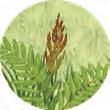
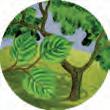

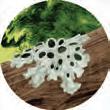



Foxglove
Spires of tall pink flowers remind us of the hazy days of summer, buzzing with bumblebees and moths.
Ferns
Throw ferns some shade in the garden so those lush, curly fronds can thrive.
Hazel
Hazel trees are great for smaller gardens, great for wildlife and can be coppiced to use as stakes.

Hypnum cupressiforme moss
This is great moss for lawns and very ecologically adaptable.
Black spot lichen
Lichens are made of fungus and algae. They survive on nutrients and moisture in the air.
Dicranum
scoparium moss
This gorgeous moss is amazing under foot - so soft and spongy and easy to maintain.
Silver birch
Birch trees don’t often grow straight in a rainforest environment. Embrace the imperfect!
Oak moss lichen
There are many types of lichen that spread slowly with wonderful names from oak moss to shaggy strap.

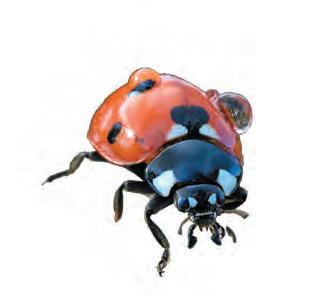
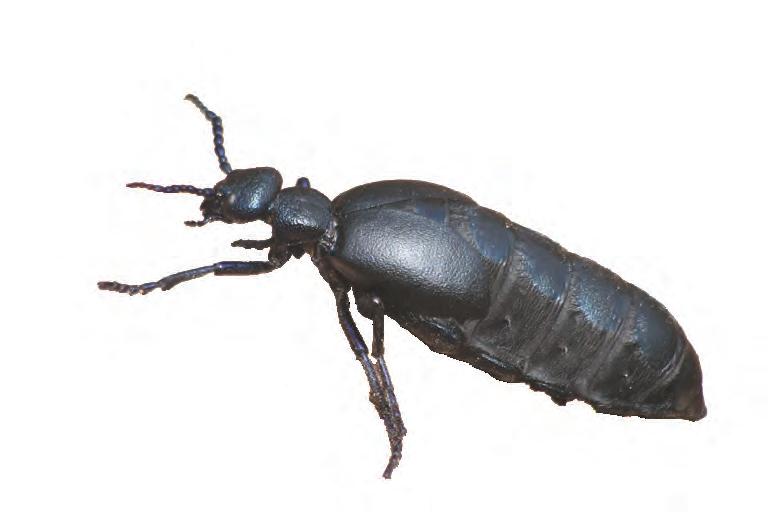
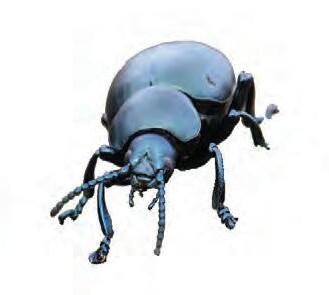
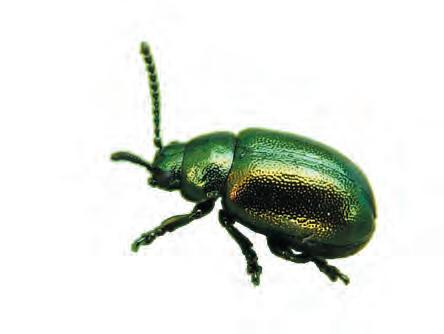
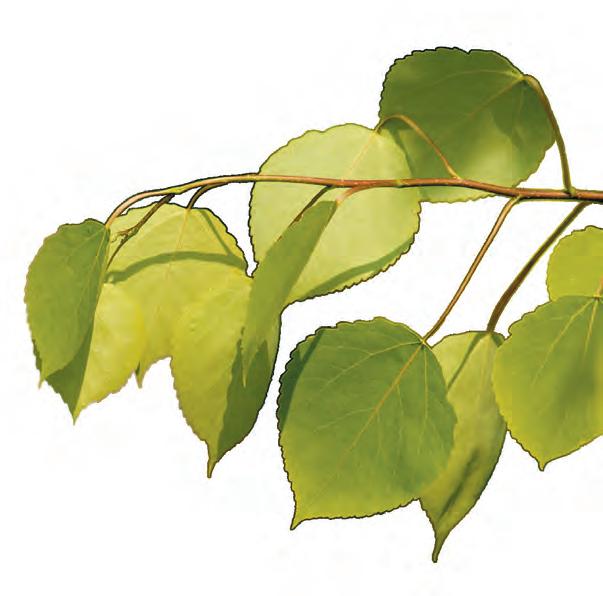
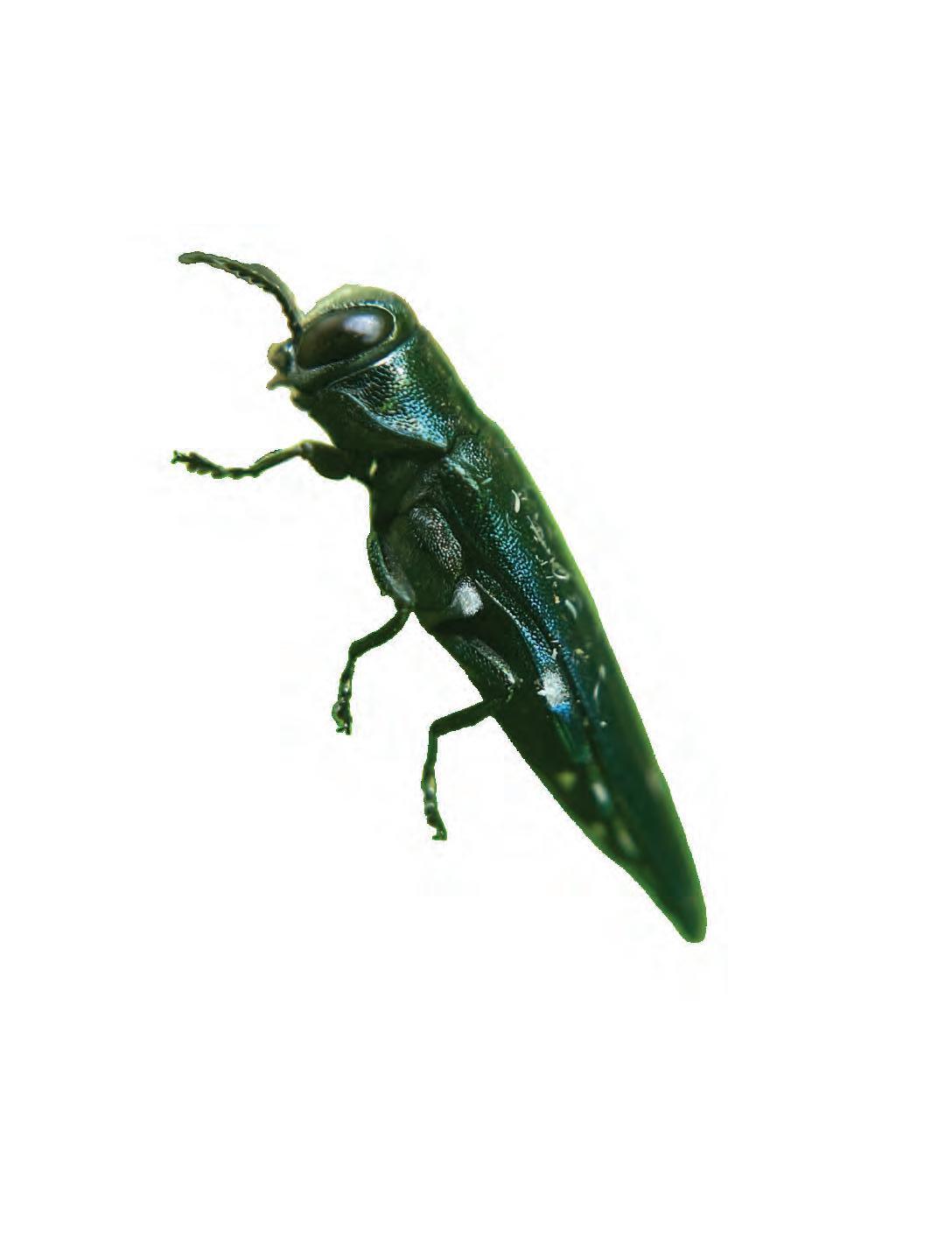
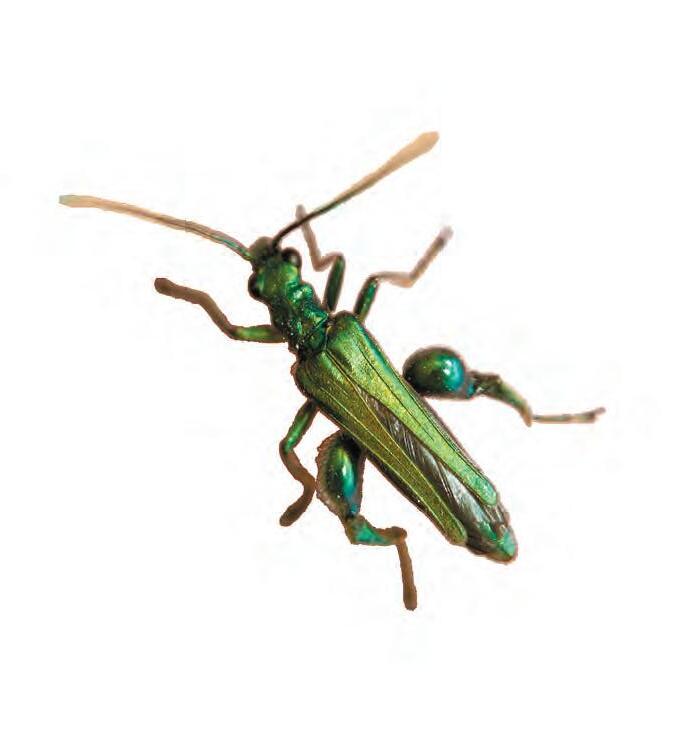
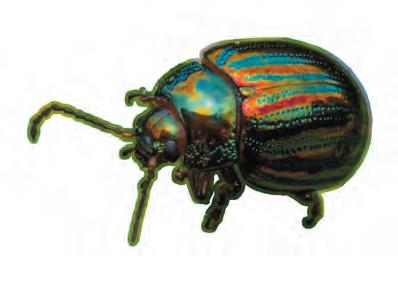


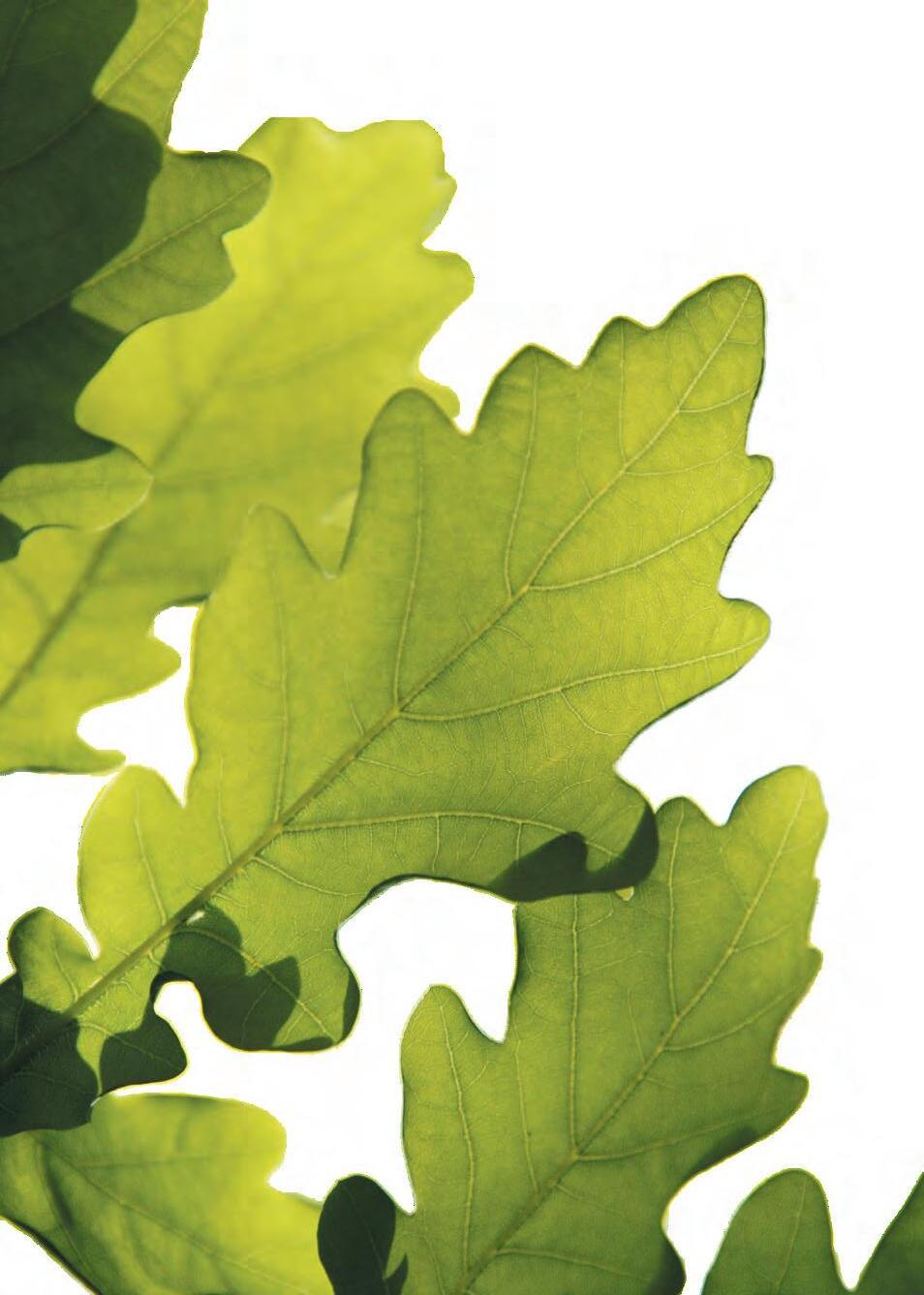
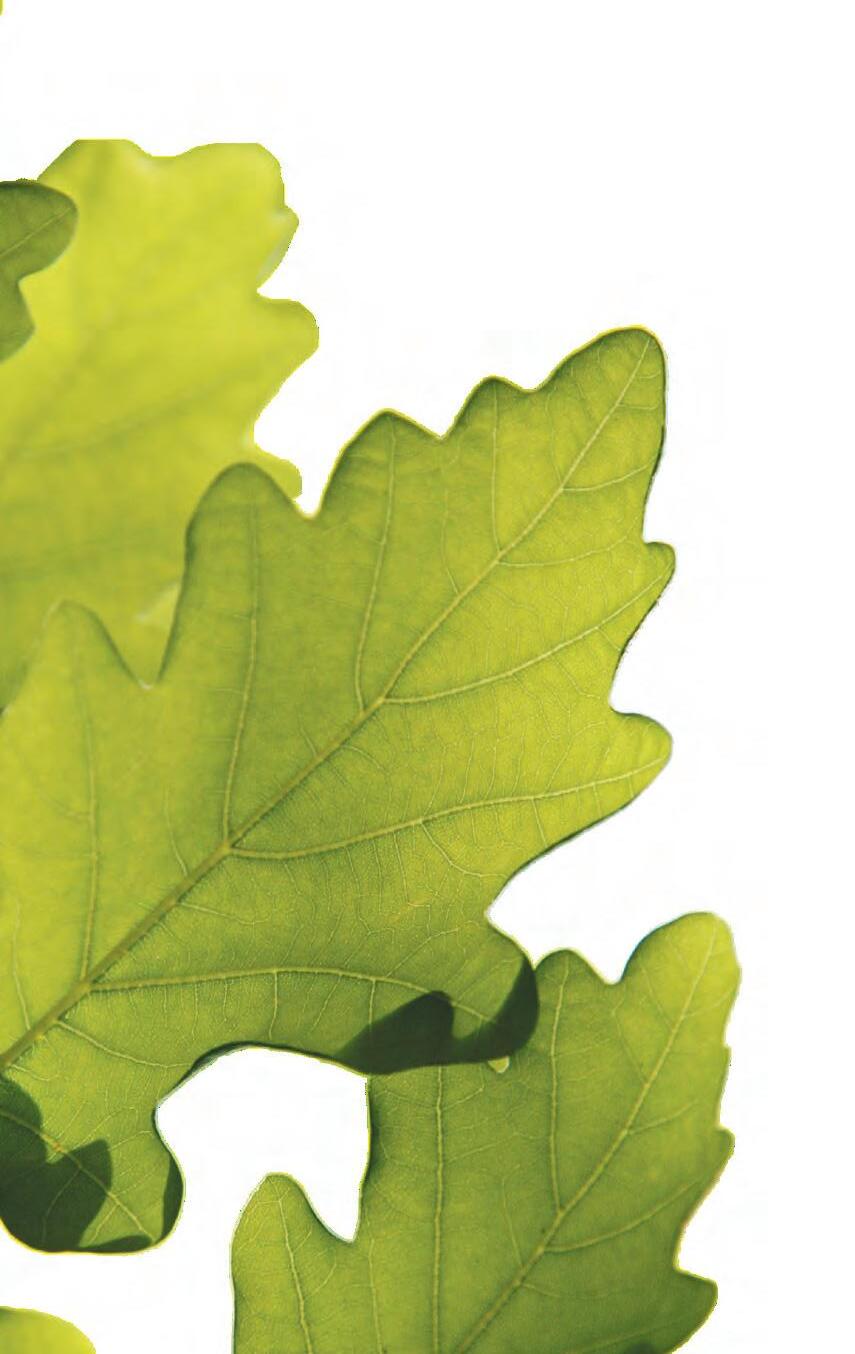
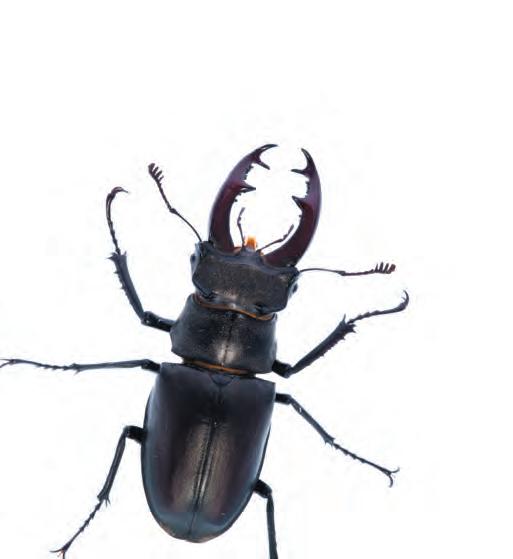
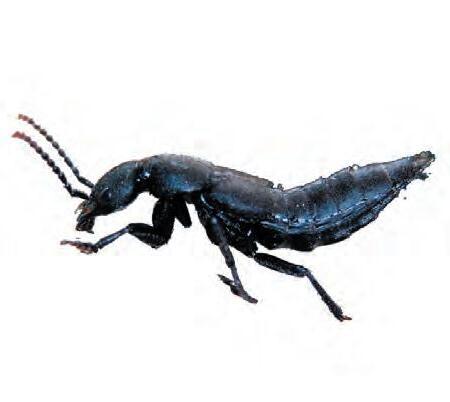
Beetles benefit from wilder gardens! Download our free guide to bring the best beetles to your patch wtru.st/Beetles

Many leaf beetles, like this mint leaf beetle, have a metallic sheen.
Like so many wild encounters, it came down to timing, research and a little bit of luck. I knew I was in the right place – patrolling a patch of grass, shrubs and saplings beneath towering birch trees. I knew it was the right season, with the late spring sun warming the morning.
But there she was, a splash of red amongst the green. Hunkered on a leaf, soaking in the sunlight, warming up for her maiden flight. A female hazel pot beetle. She was almost cartoonishly oblong, a
But I’d been here before and left disappointed.
How could I hope to spot one little beetle in a forest of foliage?
caricature of a beetle with her black head tucked beneath her bright red body. I’m not sure if it was her shape, her colour or her rarity that enchanted me, but that encounter will live long in my memory.
I’ve enjoyed similarly magical moments with many more beetles, from dazzling jewel beetles to cliff tiger beetles racing across rocks. The sheer number and variety of beetles in the UK is staggering – there are more than 4,000 of them. Wherever you look, however long you search, there will always be a new beetle to discover. They’re even more diverse than
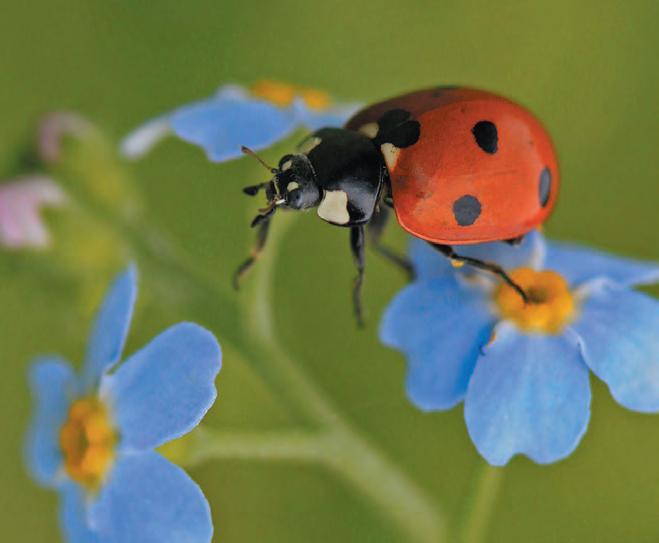
7-spot ladybirds are a familiar sight in parks and gardens.
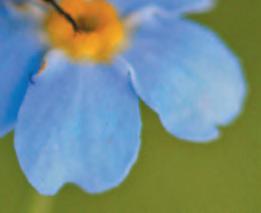
The Beatles’ back catalogue and, I think, should be just as celebrated. It’s time for a new Beetlemania!
Ladybird Madonna
If the nation had a favourite beetle, it would probably be a ladybird. They’re familiar, brightly coloured and considered the gardener’s friend, thanks to their appetite for aphids.
When you picture a ladybird, it’s likely the 7-spot, with seven black dots decorating its bright red back. But did you know there are almost 50 species to discover in the UK?
Many of them share a similar style, pairing red and black. Others can be orange or yellow. These bright colours are a warning. They let potential predators know that this meal would leave a bad taste in the
mouth. This is known as aposematic colouration. Studies have shown that brighter ladybirds tend to be more toxic, with birds less likely to attack the brighter species as a result.
The largest ladybird is the eyed ladybird, reaching a (relatively) impressive length of 8.5 mm. It’s a conifer specialist, best looked for on the branches of Scots pine. Whilst many ladybirds are found in trees, there are plenty to be discovered closer to the ground. The 14-spot ladybird stalks aphids across nettles and other low-growing plants. It’s a beautiful, bright yellow beetle, with rectangular black spots that often fuse together.
Not all ladybirds are large and brightly coloured. Almost half of our resident species are considered inconspicuous ladybirds. They’re small, subtly marked and much more difficult to find. The aptly named dot ladybird can be as little as 1.3 mm. It’s a black speck often found on fruit trees, where it hunts spider mites – helping to control their numbers.
Let it bee
Imitation is the greatest form of flattery, but it can also be an excellent survival strategy. Lots of defenceless insects have evolved to look like bees and wasps to fool predators. This is known as Batesian mimicry and there are some brilliant beetles getting in on the act.
One of my favourites is the bee beetle. It has black bands across its yellow wing cases, bringing to mind a bee’s bum. The effect is enhanced by a fuzzy ginger back and a habit of trundling across flowers. But as any good cover band knows, it’s not enough to look like your idol, you have to sound like them too. Bee beetles buzz as they fly from flower to flower. Sadly, you’re unlikely to see one away from Wales or the Highlands of Scotland.
Luckily, there’s another mimic found a lot more widely. The wasp beetle lives in woodlands across most of Britain. Yellow bands across its black body give the impression of a wasp. The beetle adds to this effect by moving in a jerky, wasp-like manner. You
Tortoise beetles look truly bizarre thanks to the large wing cases and pronotum that hide their head and body.
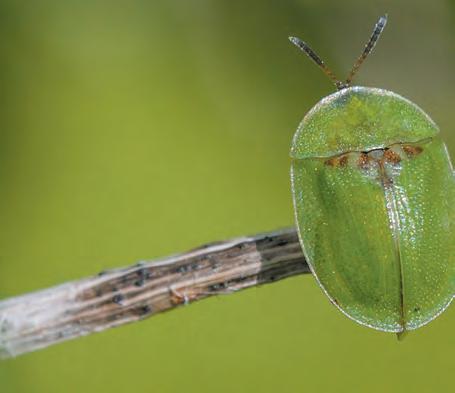
can often find wasp beetles resting openly on leaves or fences, trusting their colours to keep them safe.
Hey jewel
How do you take a beetle and make it better? You make it shiny! From shining stripes to metallic sheens, there are some gloriously glossy beetles in the UK.
Jewel beetles live up to their name, with some species shimmering emerald or bronze. But, like true precious gems, they’re hard to come by. Their larvae leave characteristic D-shaped holes in the trunks of trees, but it takes a lot of luck to spot an adult. Fortunately, there are plenty of shining beetles that are far more easily found.
For example, rose chafers. These big beetles are hard to miss, visiting flowers on a sunny day. They’re a gorgeous, metallic golden-green, their colours shifting as the sun catches them. Like many beetles, they are pollinators, fulfilling the same important role as bees and butterflies. Rose chafers are found throughout southern Britain, sometimes visiting gardens.
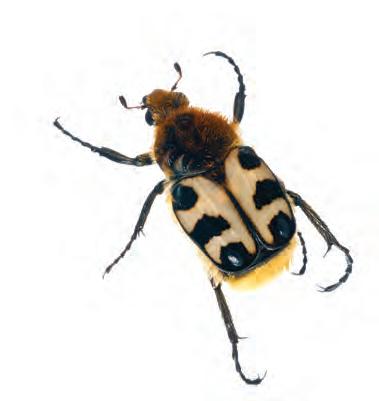
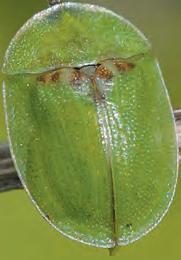
The sheer variety of beetles in the UK is staggering
Another glittering garden visitor is the rosemary beetle. Its metallic green back is embellished with striking purple stripes. It’s a recent arrival to the UK but has quickly spread. These beetles are easily found on rosemary and other aromatic plants. They are leaf beetles and share the genus Chrysolina with many equally attractive species, including the mint leaf beetle and dead-nettle leaf beetle.
Twist and snout
Let’s shake it up from the bright and bold and explore some of our more bizarre beetles. When it comes to looks, weevils have the best nose in the business – though technically it’s a rostrum with their mouthparts at the end. This long ‘snout’ gives them a comical appearance, which is only enhanced by their large and often prominent eyes.
One of the longest snouts belongs to the acorn weevil. Females use theirs to bore into an acorn, allowing them to lay an egg inside. The young weevil grows inside the acorn, eventually burrowing out to pupate in the soil. Not all weevils have such a long snout. The scarce fungus weevil’s rostrum is broad and flattened. It feeds on the fungi known as King Alfred’s cakes, its mottled pattern providing the perfect camouflage.
Whether they’re strangely shaped, shiny, brightly coloured or masterful mimics, beetles are brilliant. They are pollinators, predators and recyclers, carrying out the vital tasks that help keep wild places balanced. Let’s come together and celebrate these incredible insects.
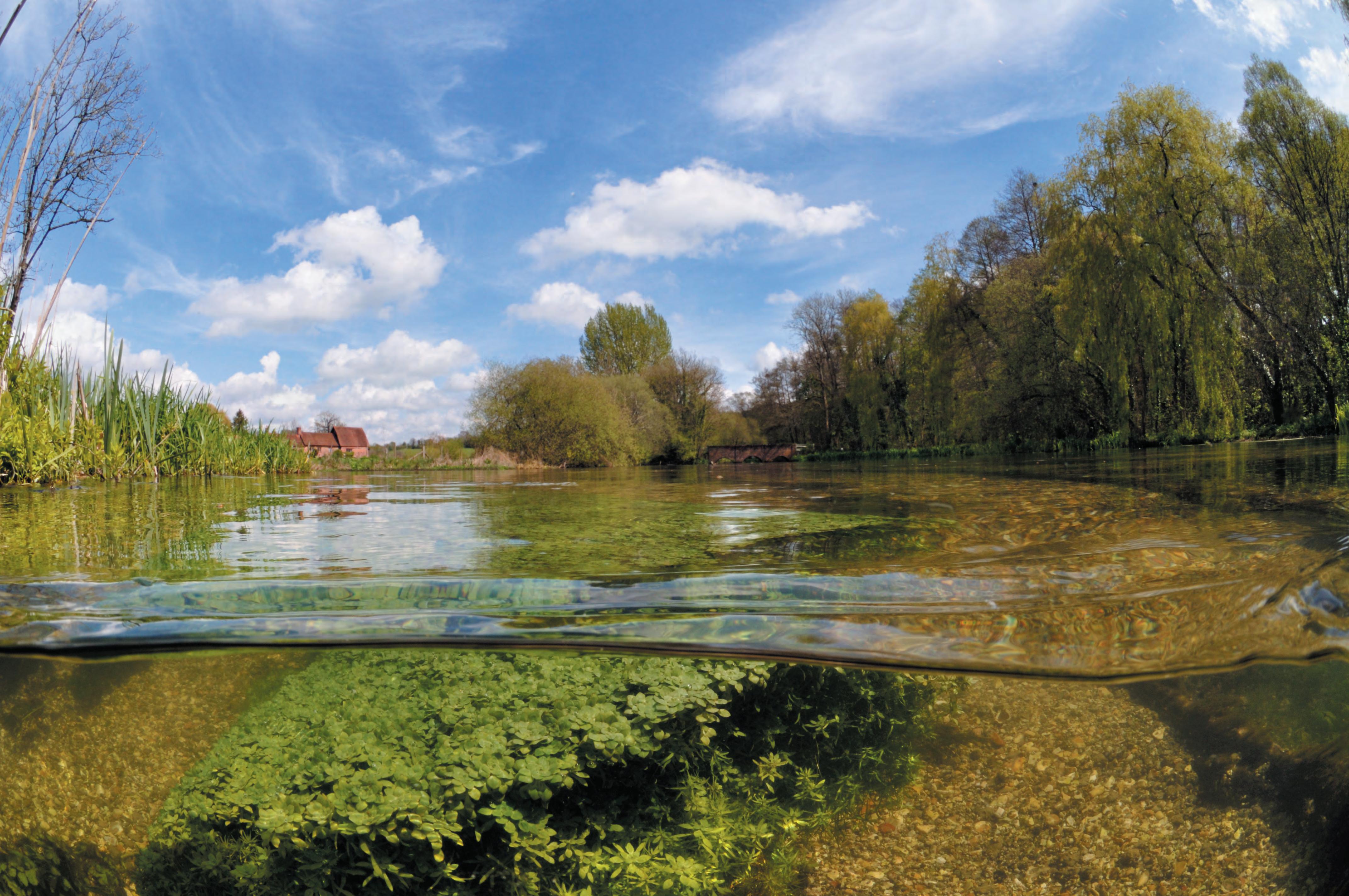
Chalk Rivers and the UK’s Growing Water Crisis
Ali Morse is Water Policy Manager at The Wildlife Trusts, working across the Trust federation, and in partnership with other organisations, to call for better protections for the water environment.
Crystal clear waters flow over colourful gravels, green fronds sway. Above, damselflies flit, wings glinting in the sunshine. I dip my fingers into the cool stream, scattering minnows. This tranquil, quintessentially English scene I hold in my mind, because the chance to see it in reality is shrinking.
Found across southern and eastern England, chalk streams are a global rarity occurring almost nowhere else. Whilst many UK rivers are rainfed, chalk streams flow from vast underground aquifers of porous chalk rock. A sunshade, filter and giant reservoir, cool, clean, consistent river flows result. The water requires comparatively little treatment to make it drinkable, making these rivers incredibly useful to society.
But whilst abstraction – extracting water for human use – won’t generally drain the river dry, not having enough water can be fatal for a river and its wildlife. Insufficient water means less physical space for plants, insects and fish, more concentrated pollution, and slower, oxygenpoor flows that warm faster in the sun (high temperatures are harmful to fish like salmon through damage to eggs, juveniles and adults).
Environmental groups have long raised concerns over excess abstraction from chalk streams or their aquifers. Extracting just 10% can potentially damage the complex local hydrology and harm particular species. And yet, for a group of rivers mostly around London – the Cam, upper Hiz, Cray, Darent and Upper Lea – more than 50% is taken. Drinking water supplies from these rivers simply aren’t sustainable.
Supply concerns aren’t restricted to chalk streams. The water company serving most of Wales said that without action, it won’t have sufficient volumes across zones that serve 70% of its customers, so it needs to invest in new supplies and in reducing demand to ensure it has enough headroom to weather any droughts. Even


in Scotland, regulators have produced a ‘water scarcity plan’ because dry periods and droughts are becoming more frequent whilst water demand in homes, farming and industry is growing. In England, the Environment Agency is updating the ‘Water Resources National Framework’, a long-term view of water needs that will show if we don’t take action, by 2050 we will fall short of the water needed for society and for rivers by 5,000 Megalitres – or 5,000,000,000 litres – per day. The greatest shortfall will be in south-east England, where chalk streams are located, but all of England faces water supply challenges.
Water supply is a key reason planning permission is refused, placing UK Government housing targets at risk. However, solutions can be found. The Environment Agency recently withdrew objections to development in Cambridgeshire after a programme of water efficiency to offset new demand and new reservoirs to ease supply issues were agreed.
Habitat enhancement projects are crucial to ensure chalk streams can endure in the meantime. Hertfordshire and Middlesex Wildlife Trust is creating a more resilient River Lea with 1.5km of woody features, bankside tree management, regrading banks and adding wetland features. The Wildlife Trust for Bedfordshire, Cambridgeshire and Northamptonshire removed redundant weirs on the River Granta, improving flows and opening up new areas of habitat to migratory fish in Cambridge.
We must all take action. Ask your MP for tighter water use requirements for new homes and to introduce a water use labelling scheme for white goods and bathroom fixtures, add a water butt in the garden, and take the 3-minute shower challenge.
Help us call upon Government to take action to protect chalk streams. Sign the petition at wtru.st/chalk-streams-petition
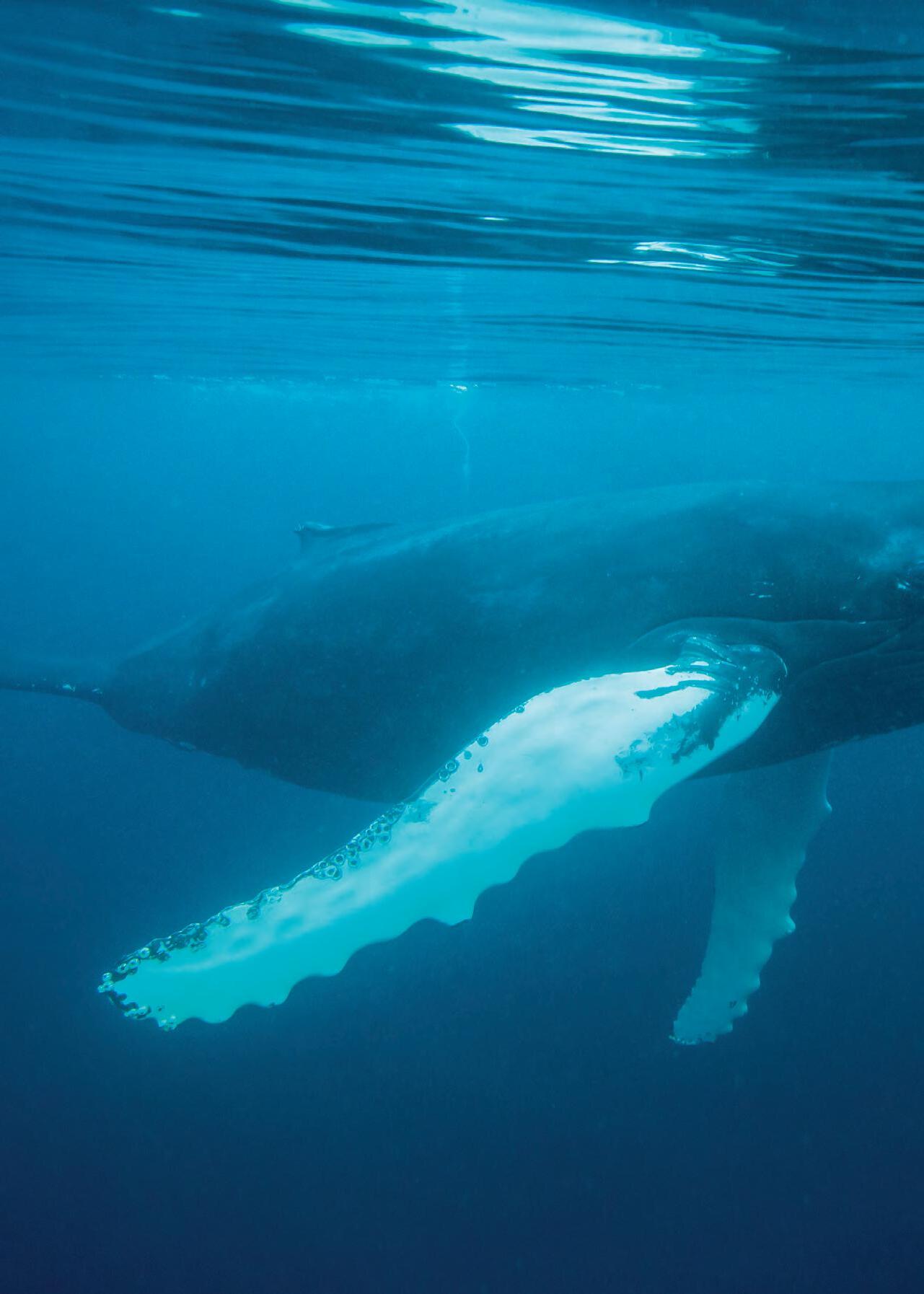
One of the greatest joys of living on an island is the chance to see some of the world’s most magnificent marine megafauna. From orcas and basking sharks to bottlenose dolphins and harbour porpoises, seeing these animals provides some of the most exciting wildlife spectacles.
Many of these species are sociable animals, often gathering together in groups or pods to feed when food is abundant. The opportunity to witness these animals increases between April and November, making summer the prime season to spot some of the 28 different species of whales and dolphins found around the UK coastline.
When you’re out on the water or watching from the coast look out for activity at the surface. Seabirds feeding, ripples on the surface or rogue waves, a glimpse of a dorsal fin or a full leap out of the water.
While encounters are unforgettable, please respect these precious ocean giants and other marine wildlife. Give them space, stay at least 100 metres (330 feet) away to minimise disturbance and use binoculars or a camera with a zoom to watch wildlife from a safe distance.
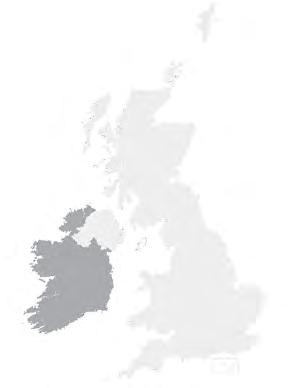
1 Isle of Eigg, Scottish Wildlife Trust
The only UK resident orcas live in the Hebrides. Other regular sightings in the Hebrides include minke whales, basking sharks and common dolphins. Visit the Isle of Eigg for guided walks throughout the summer and discover more through the Scottish Wildlife Trust’s Snorkel Trails.
Where: Isle of Eigg, The Hebrides
2 Runkerry Head, Ulster Wildlife
Some 25 species of whale, dolphin and porpoise have been recorded in Irish waters. The most frequently recorded in Northern Irish waters are minke whale, bottlenose and common dolphins, harbour porpoise and basking shark.
Where: Runkerry Head, Northern Ireland
3 Marine Drive, Yorkshire Wildlife Trust
With over 350 sightings recorded in 2024, Marine Drive in Scarborough is one of the best places on the English coast to see bottlenose dolphins and harbour porpoises. Minke whales visit frequently and humpback whales have been sighted several times during the summer.
Where: Marine Drive, Scarborough
4 Marine Drive, Manx Wildlife Trust
You can see basking sharks, minke whales and bottlenose, common and Risso’s dolphins from the Isle of Man. Grey and common seals, plus harbour porpoises can be seen year-round. For late summer minke whale sightings go to Marine Drive on Douglas Head, when the whales follow herring to their spawning grounds.
Where: Marine Drive, Douglas Head
5

Cardigan Bay, The Wildlife Trust of South and West Wales
Cardigan Bay is a hotspot for marine wildlife sightings of bottlenose dolphins, harbour porpoises and grey seals. There are occasional sightings of common dolphins, basking sharks, minke whales, sunfish and leatherback turtles during the summer months.
Where: Cardigan Bay Marine Wildlife Centre, New Quay
6 Land’s End, Cornwall Wildlife Trust
Cornwall boasts an incredible range of megafauna sightings around its coast, from common, Risso’s, bottlenosed or white-beaked dolphins and harbour porpoise, to grey and harbour seal, basking shark, blue-fin tuna, humpback, fin, minke and even the occasional orca.
Where: Land's End, Cornwall
Did you spot any megafauna?
We’d love to know how your search went. Please share your best photos with us!
@thewildlifetrusts @wildlifetrusts
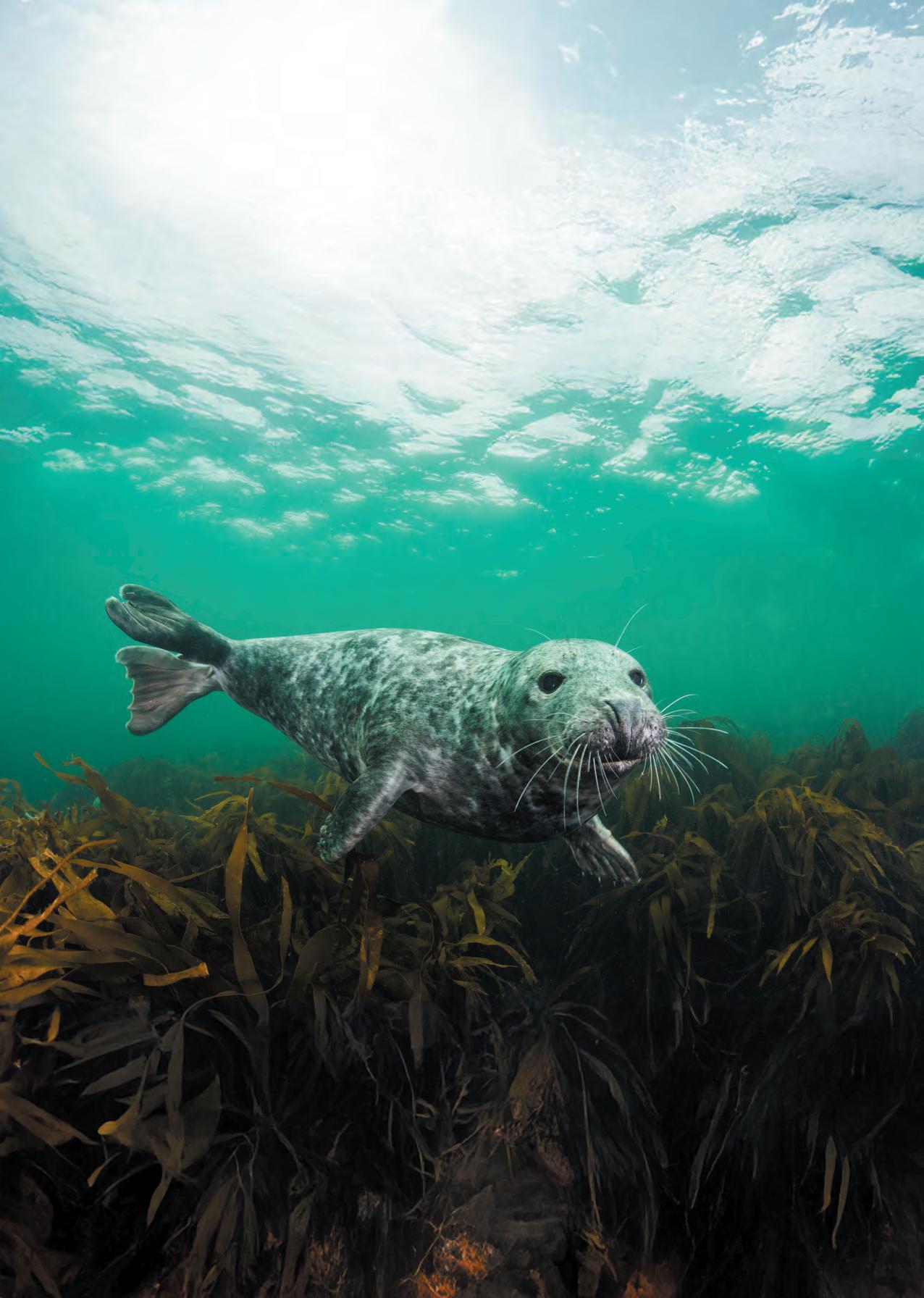
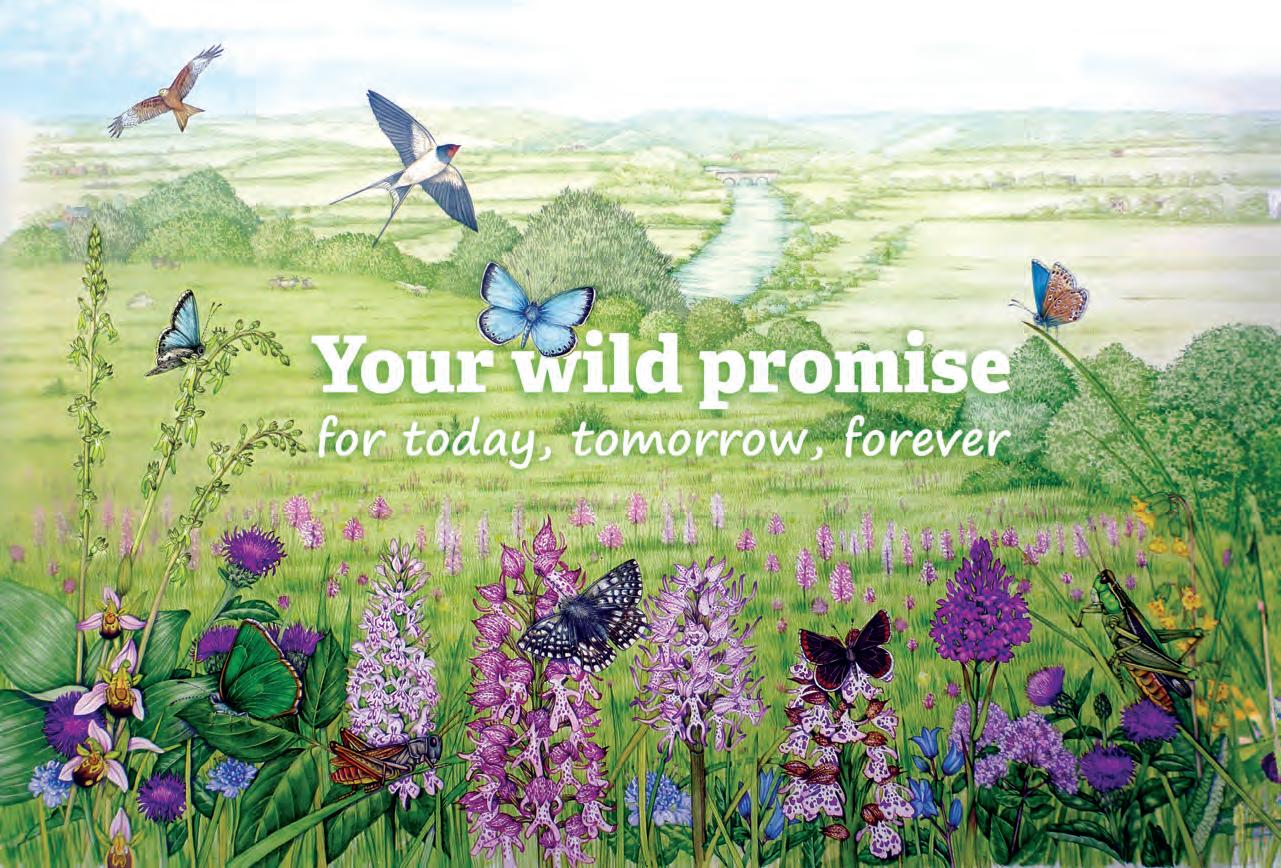
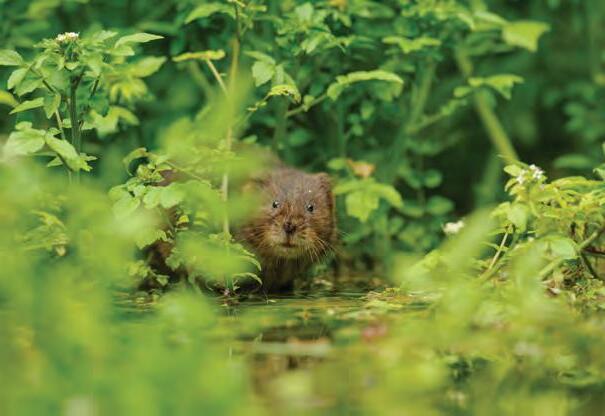
On Wednesday, John helped protect water voles.
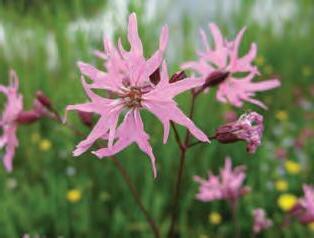

On Saturday, it was five years since John passed away.
For more information about leaving a gift in your will to BBOWT, please contact 01865 775476 and ask to speak to our Legacy Officer or visit bbowt.org.uk/gifts-in-wills